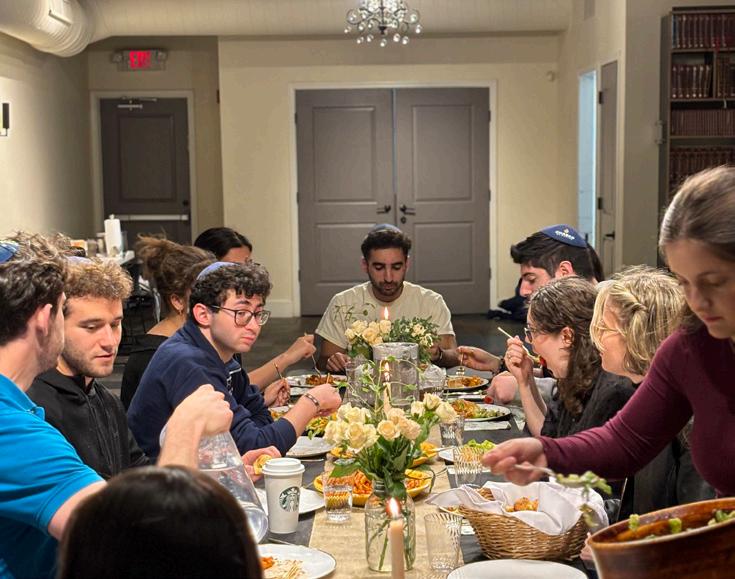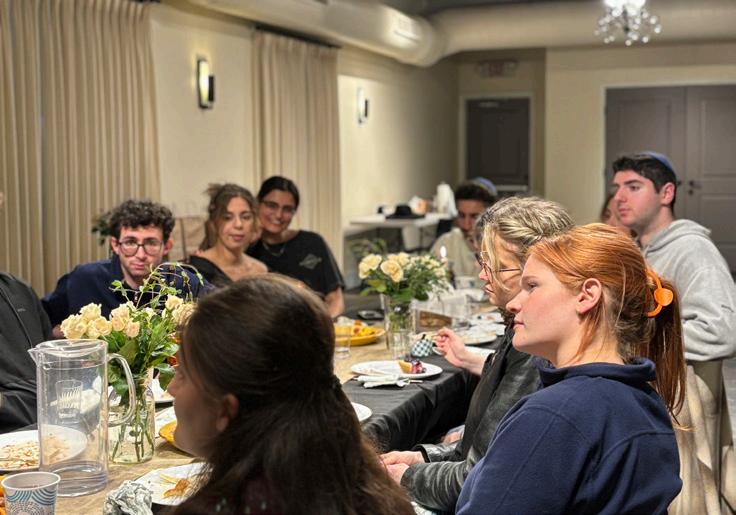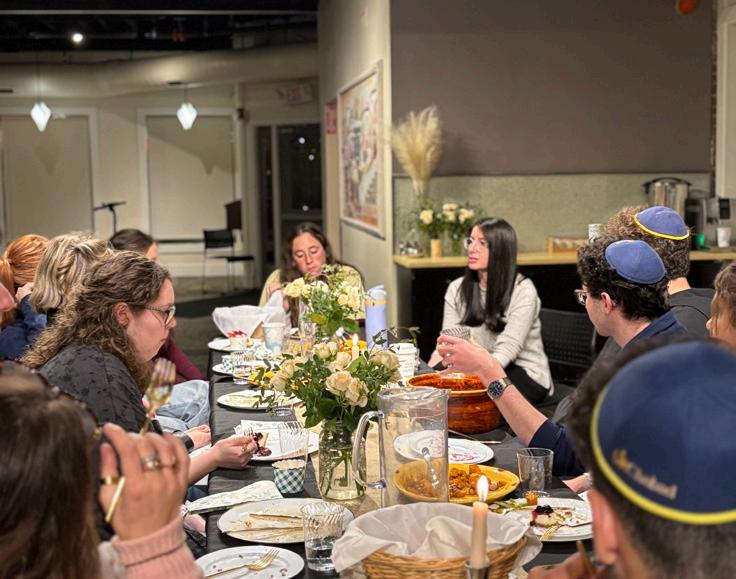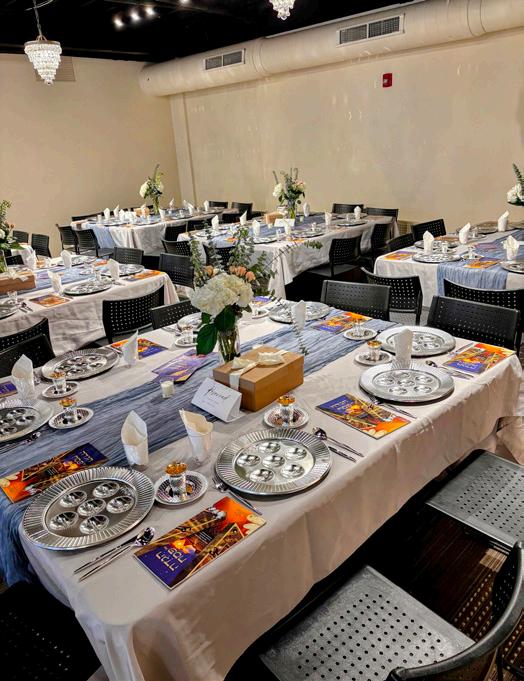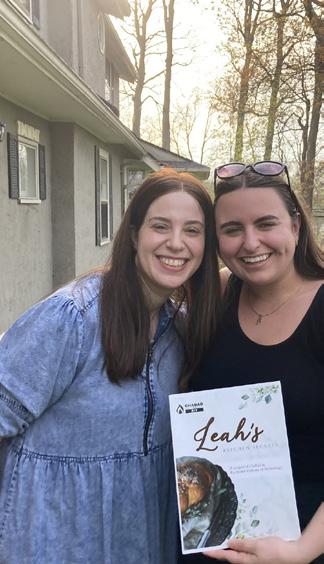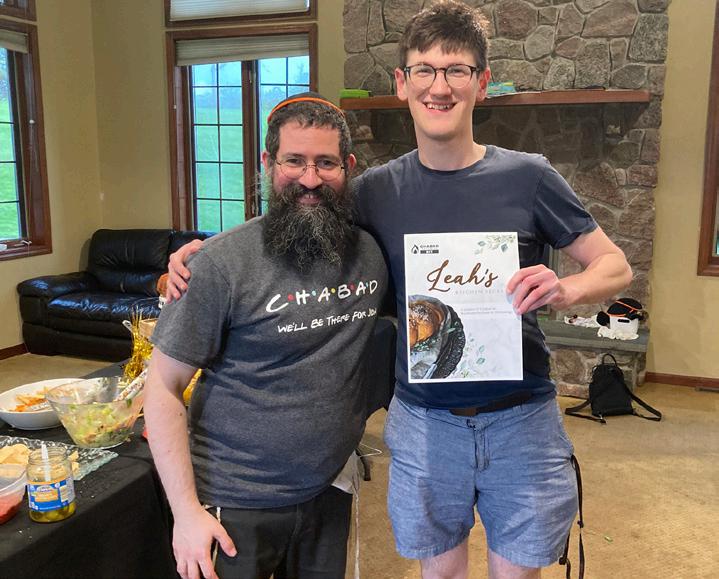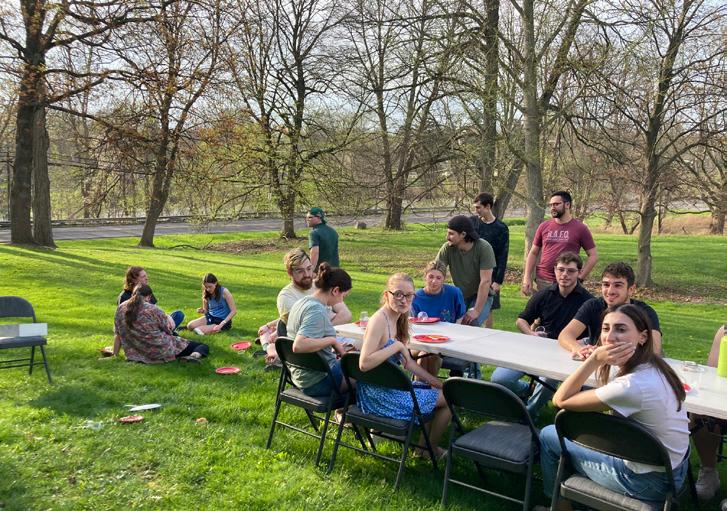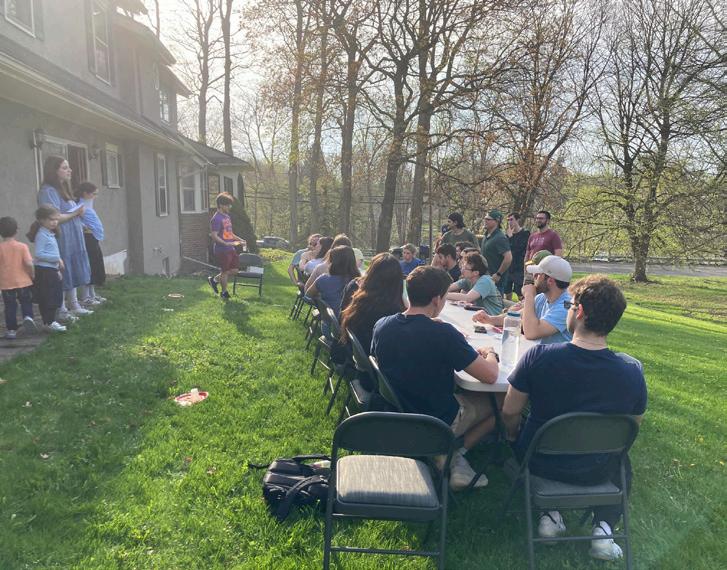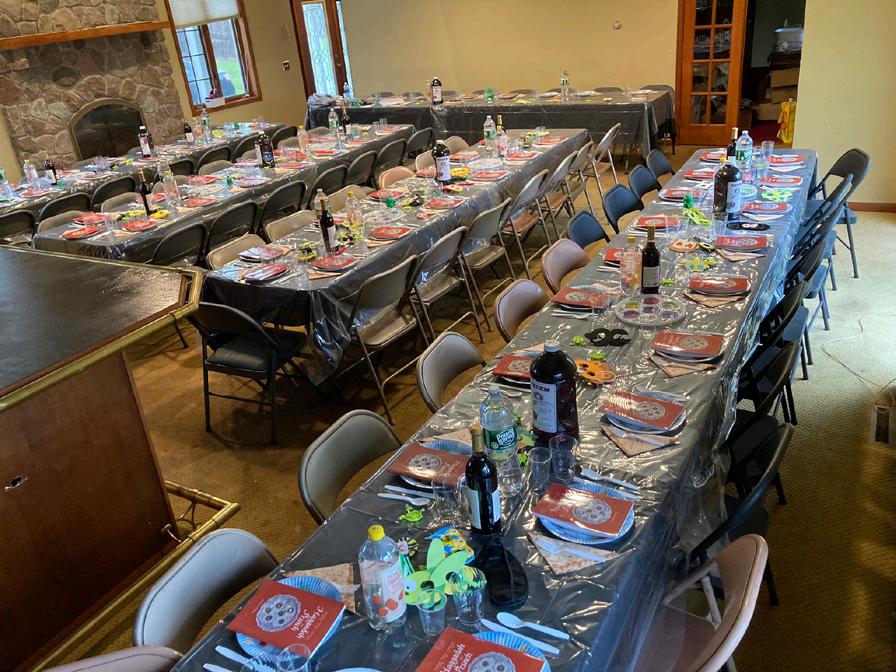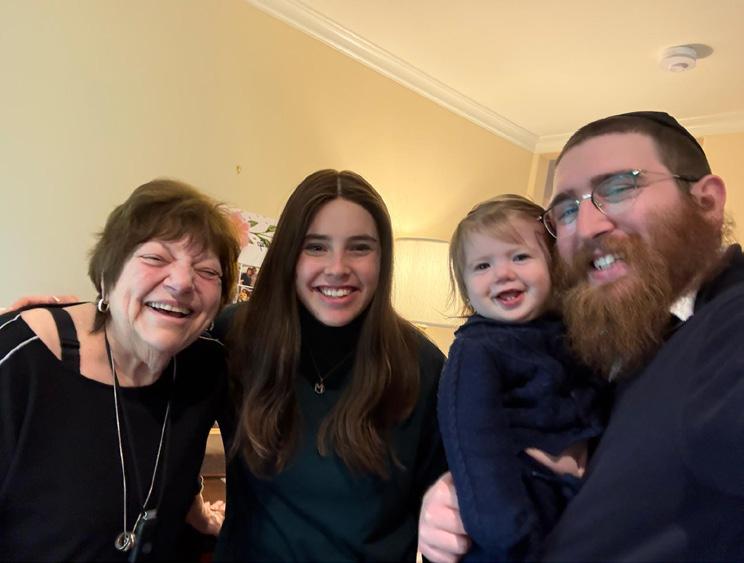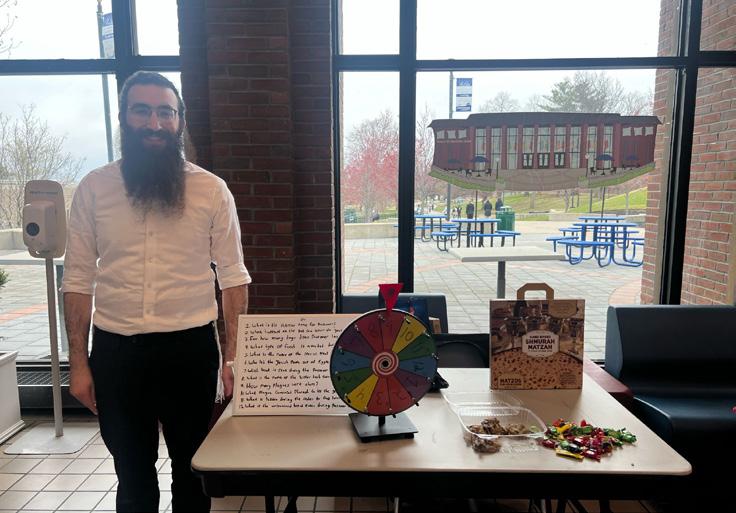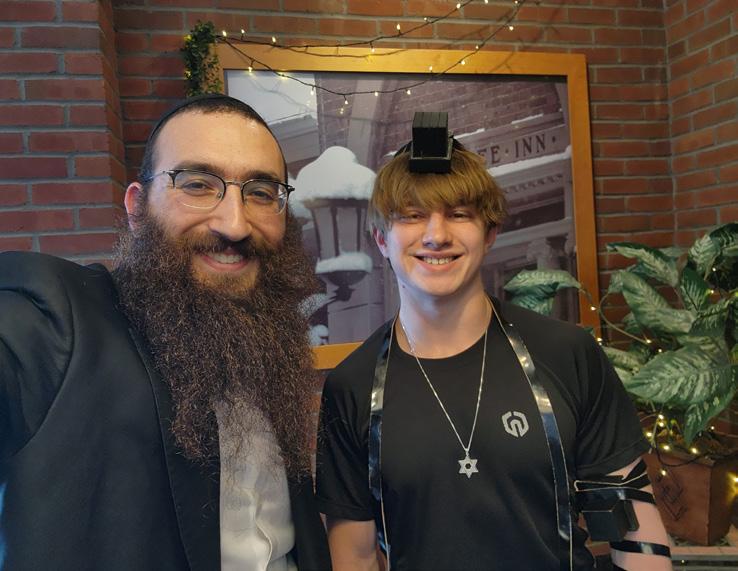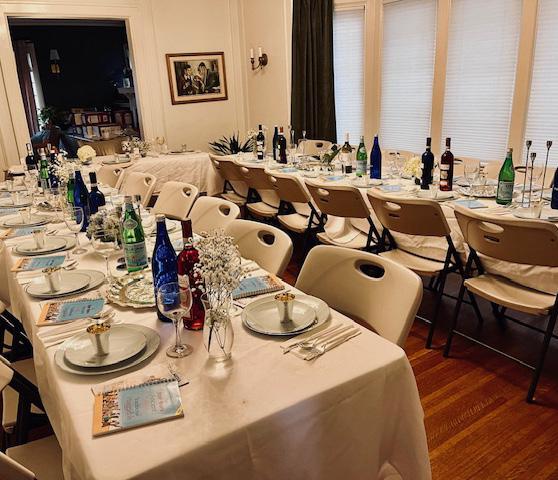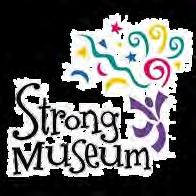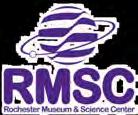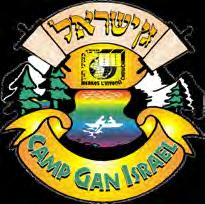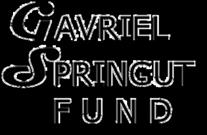

THE CHABAD TIMES
A Publication of Chabad Lubavitch of Rochester

Come to synagogue on Shavuot for the Reading of “The Ten Commandments” and reexperience The Giving of the Torah at Mt. Sinai 3,337 years ago!
Shavuot Services @ Chabad - Monday, June 2, 10:00 a.m. followed by Deluxe Dairy Pizza Kiddush


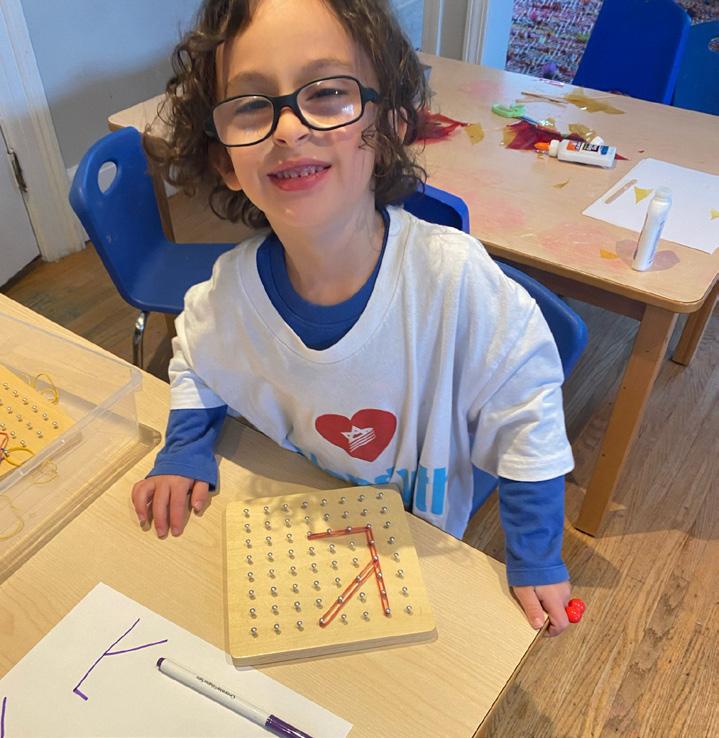
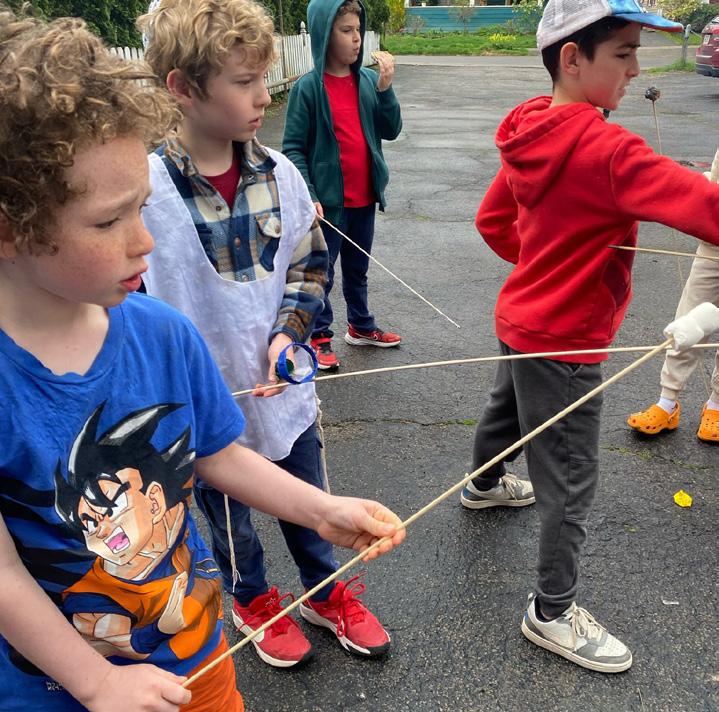
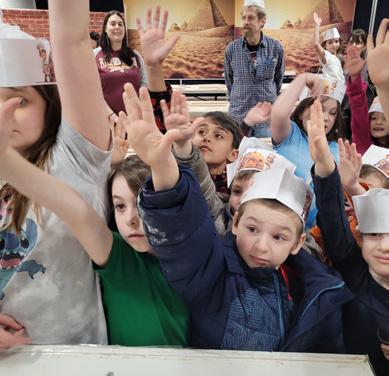
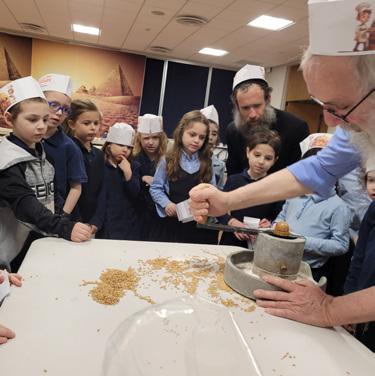

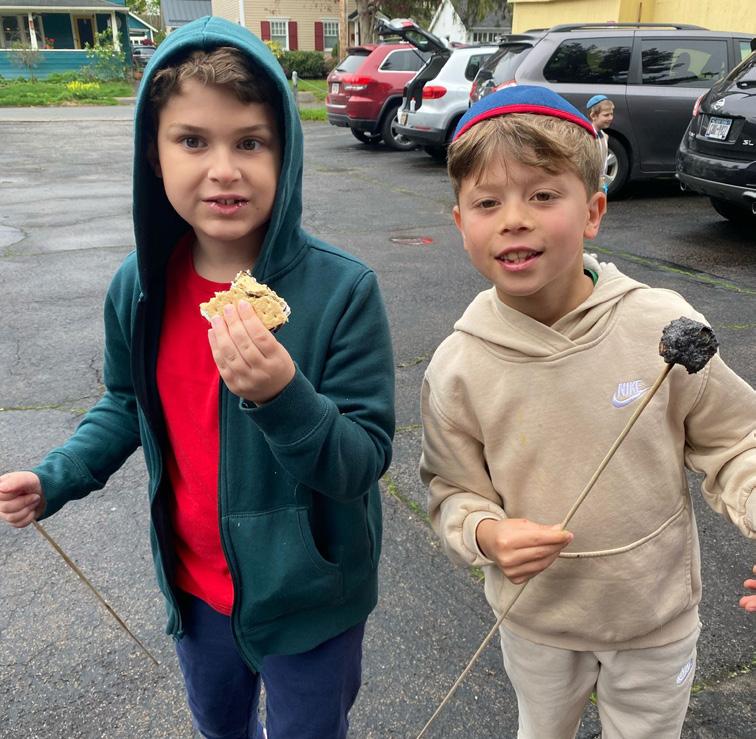
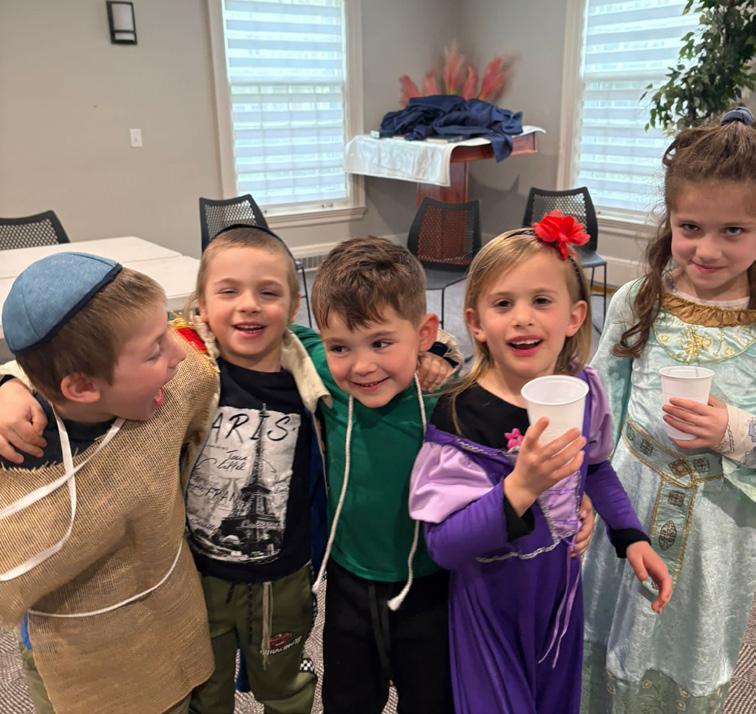
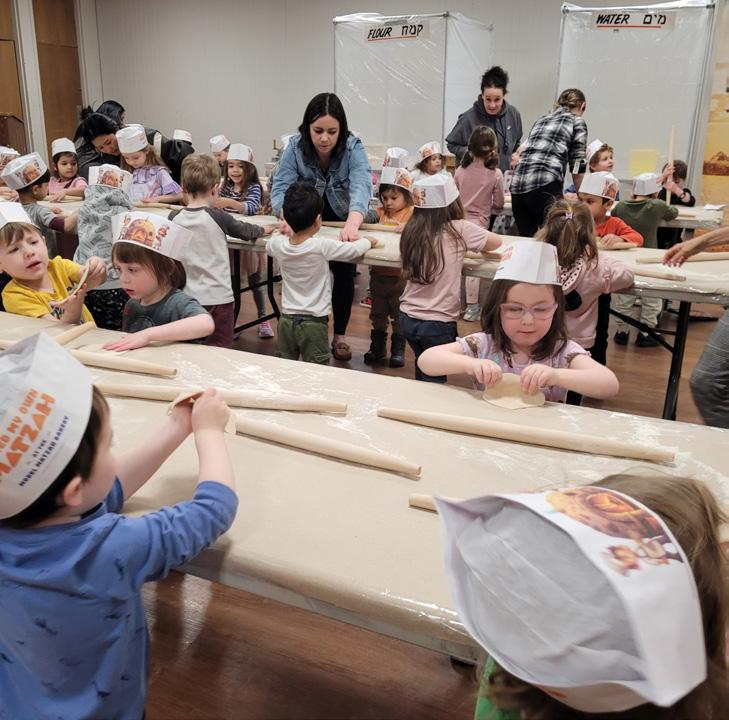
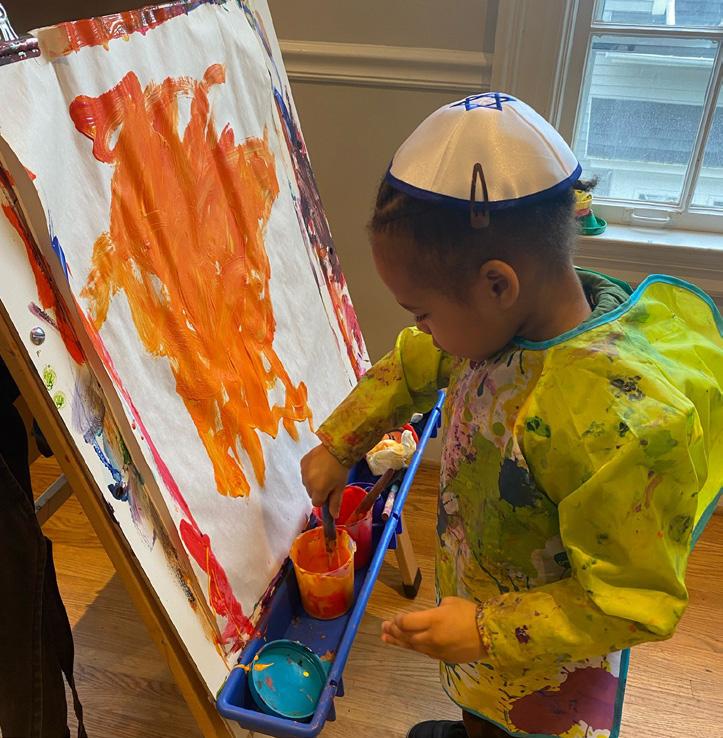
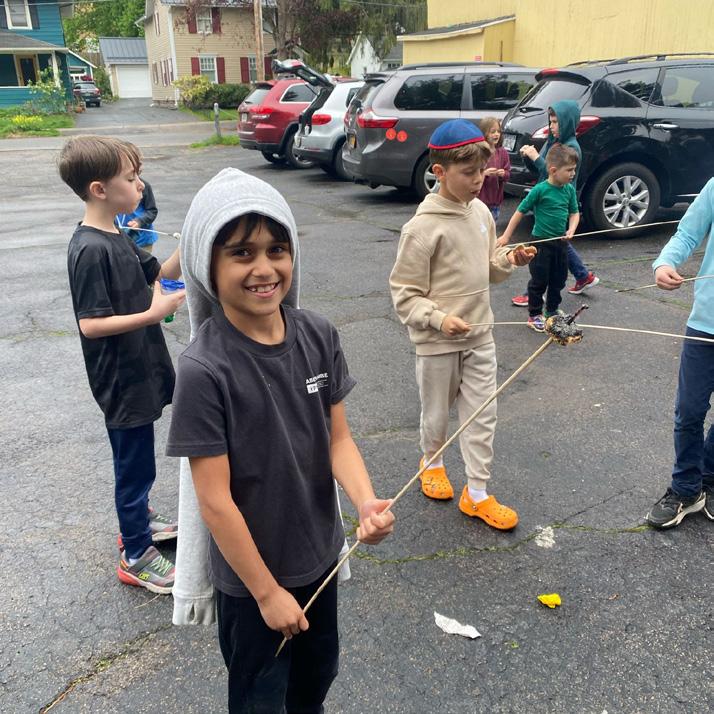
Countdown or Count Up?
Shalom Uveracha! As Shavuot approaches one notices a singular lack of frenzied activity. In contrast to prePassover intensive cleaning or pre-Sukkot Sukka building, Shavuot is relatively frenzy-free and does not require major preparation.
But don’t get me wrong: Shavuot is a major Holiday - it is on this day, 3,337 years ago, that we stood at the foot of Mt. Sinai and received the Torah from G-d. Shavuot is the anniversary of our nationhood, and, while it may be frenzy-free, we have been preparing for it for seven weeks!
Beginning on the second day of Passover we fulfill the Mitzvah of Sefirat HaOmer, the counting of the days between Passover and Shavuot. The origin of this Mitzvah is that on leaving Egypt the Jews understood that the purpose was not only to leave the slavery of Egypt but to receive the Torah and become G-d’s chosen people. They were so excited about the prospect of receiving the Torah that they literally counted the days. To recreate this excitement for Torah we too count the days – hence the Mitzvah of the Counting of the Omer. Thus Shavuot and its Torah message are on our minds for seven weeks.
- all the way to the forty ninth day. Shouldn’t we be counting down instead of counting up?
The explanation is that when we count down to a special event it’s as if we’re saying that the time between now and the anticipated event is in the way and we’d like to get it out of the way - ten days in the way, phew, only nine days in the way etc. When we count up to Shavuot we are saying that the intervening time is not the enemy but rather an opportunity to prepare for Torah - one day of preparation accomplished, two days of preparation accomplished etc.
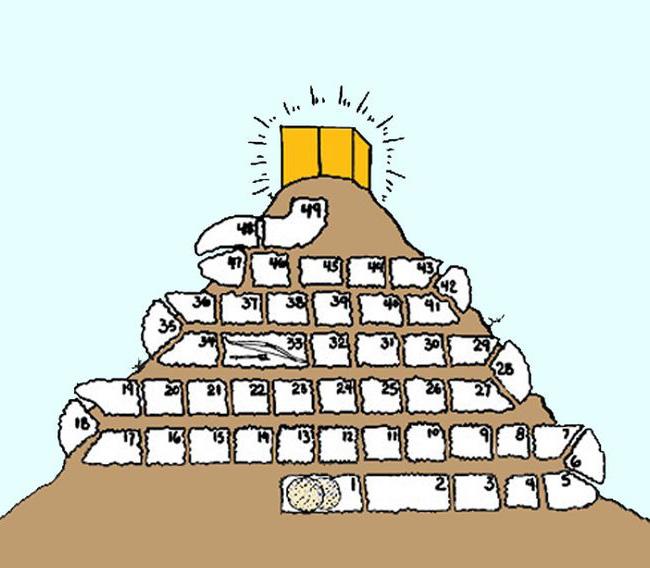
The preparation for Shavuot - counting the Omer for seven weeks - reminds us that Torah is worth preparing for, and that time is a most precious gift to be used wisely - never “in the way” to be wasted or “killed”. Time is a friend to be treated with appreciation and respect, a friend to “count” on.
However, there is a question about how we count the days. Normally, when one looks forward to a special event one counts how many days there are left; ten days to go, nine days to go etc. But when we count the Omer, we count the other way; one day of the Omer, two days of the Omer
Kessler Family
Chabad Center 1037 Winton Rd. S. Rochester NY 14618 585-271-0330 chabadrochester.com
Rabbi Nechemia & Chanie Vogel
Rabbi Dovid & Chany Mochkin
Chabad Of Pittsford 21 Lincoln Ave. Pittsford NY 14534 585-340-7545 jewishpittsford.com
Rabbi Yitzi & Rishi Hein
The Midrash relates that the only Torah guarantors acceptable to G-d were the Jewish children. With such a central role in the events of Shavuot, it is thus fitting that all children, even tiny infants, be present in synagogue when the Ten Commandments are read from the Torah on the morning of the 1st day of Shavuot (Monday, May 2). After all, they are the next link in the unbroken golden chain of tradition.
Wishing you a Happy & Inspiring Shavuot!
Chabad Lubavitch of Rochester
Chabad Lubavitch of Rochester NY
Chabad Young Professionals 18 Buckingham St. Rochester NY 14607 585-350-6634 yjprochester.com
Rabbi Moshe & Chayi Vogel
Rohr Chabad House @ U of R 955 Genesee St. Rochester NY 14611 585-503-9224 urchabad.org
Rabbi Asher & Devorah Leah Yaras
Chabad House @ R.I.T. 3018 East River Rd. Rochester NY 14623 347-546-3860 chabadrit.com
Rabbi Yossi & Leah Cohen
Chabad House @ SUNY Geneseo 650-675-8282 chabadgeneseo.com
Rabbi Laivy & Goldy Mochkin
Chabad Sunshine Circle 585-200-9709 chabadrochester.com
Rabbi Mendel & Mussi Vogel
N.Y. 14618 To advertise in the Chabad Times, visit Chabadrochester.com/ctimes We are not responsible for the Kashruth of any product or establishment advertised in The Chabad Times.
The FiFTieTh Miracle
Adapted from the works of the Rebbe
No two festivals on the Jewish calendar are more coupled than Passover and Shavuot. And no two festivals seem further apart conceptually.
We proceed from Passover to Shavuot along the pathway of the 49-day Omer Count which delineates them both. The Omer period always begins on the second day of Passover and ends with Shavuot. Shavuot is defined by the Torah as the day following the Omer Count - the 50th day after Passover. Shavuot is thus the only festival on our calendar not set by the date of the month but by its position vis-a-vis another holiday: Passover defines Shavuot.
Yet when we look at these two festivals, we discover that they represent differing, even opposite, ideas. Passover is called by the Torah the festival of “leaping” (Pesach). We leap out of exile on the heels of ten supernatural Plagues. We are guided across a sea that splits open and then engulfs our pursuers in a process that violates every law of physics and chemistry. A nation of slaves, uncoiled a mere six days from the fetishism of Egyptian idolatry, perceives “more than the prophets” and sings a sublime song of transcendent beauty!
iNK & STONe
by Yanki Tauber
by Shlomo Yaffe
In contrast, Shavuot is called by the Torah Chag Habikkurim “The Festival of the First Fruits”. In the Temple period it marked the beginning of the wheat harvest and the first use of the new crop by a communal offering of loaves of wheat-bread in the Temple as thanks for blessings of the harvest.
Shavuot also marks the giving of the Torah, which, though a supernatural experience, actually marked the beginning of the era of the natural, the human and the ordinary in Jew-
To
see G-d in the “fireworks” of the Egyptian Exodus is something that even a child can do. As our sages say, “A child at the splitting of the sea saw more than the prophet Ezekiel” Indeed, how could he not?
ish life. From the moment the Torah was given to the Jewish people, G-d decreed that “It (the Torah) is not in the heavens” but in our world. Only human beings can now interpret the
The Torah comes in two forms: written and engraved.
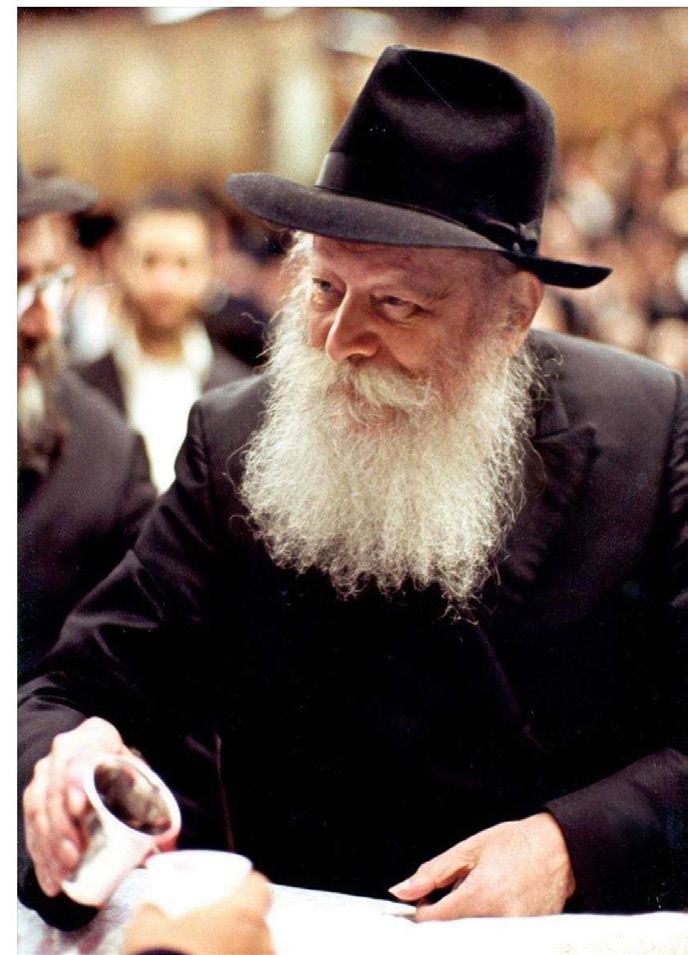
Torah and its rulings. Furthermore, all of the Torah’s precepts (mitzvot) are defined as certain actions that are done with certain objects in precise mandates of time, mass, volume and space - the very boundaries of the natural world.
Nevertheless, the primary name used for this festival, Shavuot (“weeks”), refers to the seven weeks of the Omer. Seven weeks of a seamless continuum which define Passover and Shavuot as a single entity.
We are told by the Talmud that a farmer “believes in the Life Source of the Worlds and (therefore) sows”. At first glance this seems a poor example of faith - one sows because it
On the last day of his life, Moses inscribed the Torah on parchment scrolls. But this written Torah was preceded by an engraved Torah: forty years earlier, at Mount Sinai, the Divine law was given to us in the form of Ten Commandments etched by the hand of G-d in two tablets of stone.
When something is written, the substance of the letters that express it—the ink—remains a separate entity from the substance upon which they have been set—the parchment. On the other hand, letters engraved in stone are forged in it: the words are stone and the stone is words.
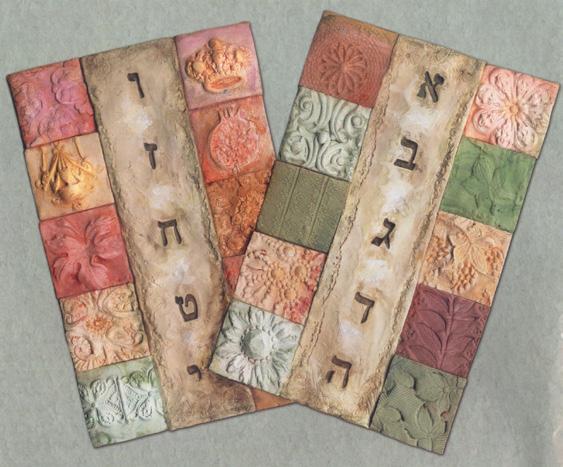
By the same token, there is an aspect of Torah that is “inked” on our soul: we understand it, our emotions are roused by it; it becomes our “lifestyle” or even our “personality”; but it remains something additional to ourselves. Yet there is a dimension of Torah that is engraved in our being - the dimension of Torah which expresses a bond with G-d that is of the very essence of the Jewish soul.
is a fact of nature that sowing seed brings a harvest in its wake, and we all need to eat.
In truth, this is the whole point of the progression and growth that we experienced as a people in those momentous seven weeks between the first Passover and that first Shavuot.
To see G-d in the “fireworks” of the Egyptian Exodus is something that even a child can do. As our sages say, “A child at the splitting of the sea saw more than the prophet Ezekiel”. Indeed, how could he not? The miracles made it obvious that the “Hand of G-d” was at work in the wholesale upending of the natural order.
Far deeper and more mature is the understanding that the natural cycle is no less a miracle than the splitting of the Red Sea and all the miraculous drama of the Exodus. Both flow exclusively from G-d’s essence. The only difference between the natural and the miraculous is frequency.
It is an axiom of Judaism that creation is an ongoing process. At every
moment, the flow of divine energy is being condensed into the stuff of our bodies and souls and of every entity in all of Creation; were it to cease for even a split second, we would cease to exist instantaneously and utterly - it would be as if we never had existed. So it is clear that no accomplishment can be made, no purpose attained, without the energy for it flowing from the Source of all life.
This is reality; we need only to look beneath the surface of things to perceive it. Sometimes it leaps above the surface on its own - that is a miracle. When that happens, seeing is no longer a choice: it is there before our eyes.
When our perception is driven by the force of the novel and the spectacular, we are passive bystanderswe are “forced” into recognizing our relationship to G-d. But when we choose to see G-d’s essence in the first green shoot of wheat, this is our accomplishment. We have found G-d not as an external force impacting

our world, but as the very fabric of our (seemingly) ordinary being.
Nature exists because G-d chose the natural order as the “default” option for all time. Miracles, on the other hand, are a concession to the human need to see things from a different perspective in order to apprehend what they’ve already seen.
G-d entrusted us with a “natural” existence because G-d has faith in our capacity to find the essential reflected in each moment of our lives and in each strand of the natural world.
G-d takes us from the obviousness of Passover and impels us - with confidence in our success - to the subtlety of Shavuot. This is because as much as we think of “faith” as our belief in G-d, there is an equally significant faith - the faith G-d has in us. G-d knows that with the light contained within Torah we have sufficient illumination to find - and live - the Gdliness that is the core of each being and the fabric of every moment.
The Rochester Jewish Art Calendar 5786 September 2025 - September 2026
Your Ad/Greeting will be visible all year long to the entire Rochester Jewish Community
• 32 full color pages
• Large size: 10" by 14" closed, 20" by 14" open
• Big boxes that are very useful for appointments, notes, etc.
• Jewish Holidays are clearly shown
• Beautiful full color art on each page
• "The Month in Jewish History" feature
Visit: chabadrochester.com/artcalendar

11 Shavuot Meditations
by Tzvi Freeman
1. Post-Sinai
Before Sinai, there was earth and there was heaven. If you wanted one, you abandoned the other.
At Sinai, the boundaries of heaven and earth were breached and the human being was empowered to fuse the two: To raise the earthly into the realm of the spirit, and to bring heaven down to earth.
Before Mount Sinai, the coarse material of which the world is made could not be elevated. It could be used as a medium, an aid in achieving enlightenment, but it itself could not be enlightened. The spirit was raised, but the earth remained dark.
At Sinai we were empowered to take physical objects and transform them into spiritual artifacts.
Our forefathers’ task was to enlighten the souls. Ours is to transform the darkness of a material world into light.
2. Mission From Sinai
The first laws the Torah deals with, immediately after the Ten Commandments, are the laws protecting a Jewish servant.
Because the first thing a Jew must know to fulfill Torah is that it is his mission in life, his entire life.
We are all servants of the Infinite Light, the channels by which it enters the universe.
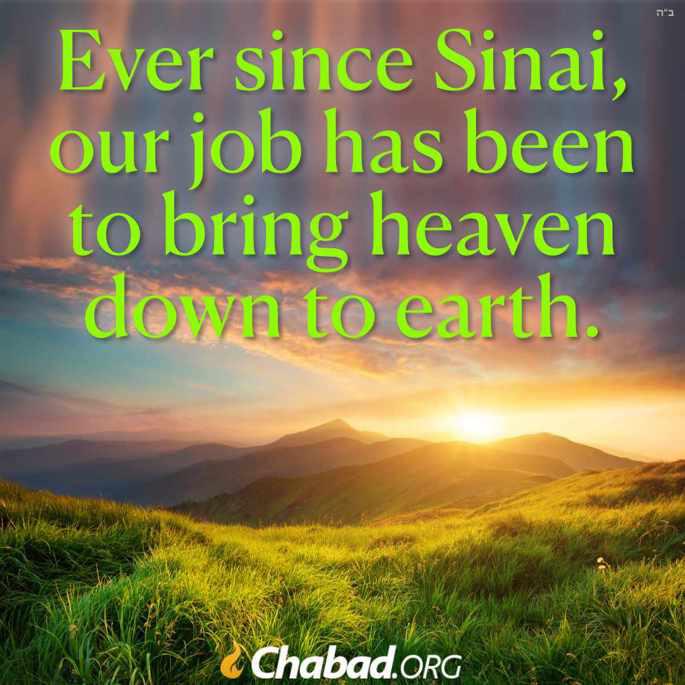
3. With One Heart
“Israel camped there by the mountain.” (Exodus 19:2) “They camped like a single person with a single heart.” (Rashi)
We Jews are a diverse people of many minds and opinions, fond of dispute for the sake of heaven. It is a strategy that has stood us well, fostering wisdom and resilience throughout our long history.
Admittedly, at times, the heavenliness may vacate the discussion. That’s when anger and rage erupts, tearing us apart into stubborn factions, weakening the integrity of the whole.
Invariably, our enemies take advantage of this rupture with a vicious attack.
But in response to the crisis, we become one again. The rupture is healed, and the enemy is swiftly vanquished.
You might imagine that this phenomenon of unity under duress is a chimera, a mere artifact imposed by external circumstances.
Not so, says Rashi, the wise teacher who teaches Torah to every Jew, tucking precious jewels of wisdom within the cloak of his simple commentary.
When Pharaoh and his entire army came chasing after the Jews as they were entrapped by the Sea of Reeds, the Torah writes only that “Pharaoh approached.” Rashi explains that the Egyptians came with one heart, as though they were a single person.
Note the nuance: First the heart, then the person. Meaning: Their hearts were driven by the same greed, so they acted as a single person.
When the Jewish nation camped before Mount Sinai, the Torah refers to the entire nation in the singular - unlike all other encampments. Rashi explains that they camped there like one person, with one heart.
First the person, then the heart.
We, the Jewish people, are truly a single being. That integral oneness may surface through many means, an unfortunate circumstance being one of them.
But if we want that oneness and harmony of a multitude of parts to last, there is only one way.
When our hearts are open to receive G-d’s Torah from wherever it may come, with humility and with joy, only then are we a healthy and whole people.
4. Penetrating Wisdom
At Mount Sinai, tradition tells, there was no echo. Why? Because Torah penetrates and is absorbed by all things.
There is no place where it does not apply, no darkness it does not illuminate, nothing it cannot bring alive. Nothing that will bounce it back and say, “Torah is too holy to belong here.”
5. Do, Then Know
When you approach any human wisdom, you must first understand and discern. You must say, “This makes sense to me; I will follow this. This is a teacher with a good reputation; I will consider her lessons. This doesn’t fit for me; I will put this aside for now.”
Not so with learning Torah. We already know Who is behind this wisdom. We are not interested in the knowledge per se, but in Him. To make His thoughts our thoughts, His mind our minds. To achieve perfect oneness with the One Above.
At Sinai, we understood this well. When Moses asked us if we were ready to accept the Torah, we answered, “We will do, and we will understand.”
First, we said, “We will do.” Because we understood Who was asking us and we desired to connect with Him.
Then we said, “We will understand.” We would take upon ourselves a venture that should be entirely impossible, only now made available to us through divine intervention:
To know the divine. To bring His thoughts into our thoughts, His mind into our minds. To become one with Him.
6. Disruptive Torah
I am G-d, your G-d who took you out of the land of Egypt to be your G-d… Do not steal. Do not kill. Do not covet.
If Torah is divine wisdom, you would expect it to enter the world in a serene voice. You would expect to hear that voice speak of the mysteries of life and open wide paths of profound contemplation.
Instead, amidst thunder and lightning, we heard simple, obvious morals: don’t steal, don’t kill, don’t covet.
Because G-d was telling us that from this point on, everything will be turned on its head.
Before Sinai, where did you find divine wisdom?
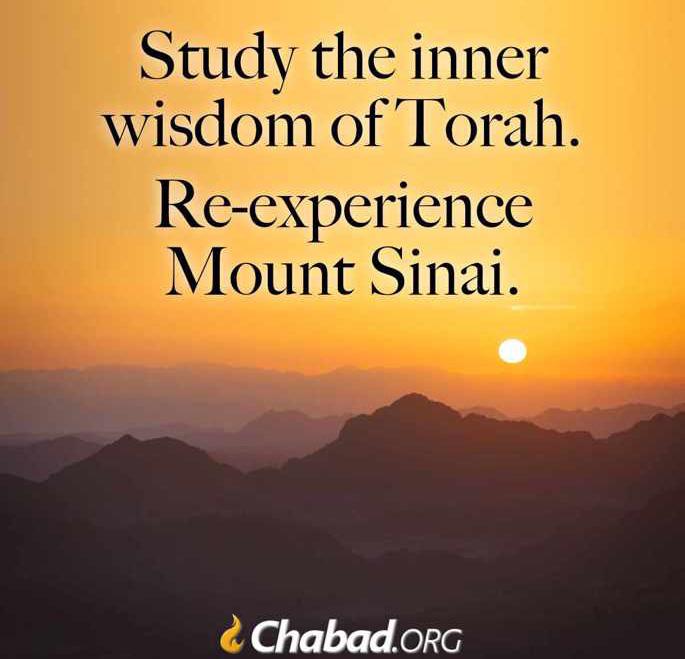
Within an enlightened soul sitting beneath a tamarisk in deep contemplation, communing with the oneness of the universe.
After Sinai, you can find Torah in a human being enslaved to a substance that kills, incapable of escape - until thrown this rope of divine wisdom and choosing of his own will to pull himself out with it and rewrite his entire journey.
For him, G-d said, “I am G-d who took you out of Egypt.”
You can find Torah in the guy who is tempted to theft and murder, who sees these as convenient alternativesbut refrains because G-d said, “Do not steal. Do not murder. Do not even covet.”
And if you can’t find Torah there, because you haven’t sunk to that extreme, and you don’t know anyone who has... then find Torah by changing the way you live day to day, the things you speak, the actions you take. By disrupting your everyday world. By leaving nothing as it is.
That is why Torah was given with lightning and thunder.
Because, post-Sinai, Torah is found in this busy, noisy world. Torah is where the action is.
Post-Sinai, everything has changed. Because Torah has to change everything.
7. Breaking Limits
Everything a human being is given comes in a finite package. Even the tablets Moses carried down from Mount Sinai were defined and bounded.
And so, when G-d saw Moses mourning over the broken tablets, He said, “Your powers were focused when you smashed the tablets. For now you will receive a Torah you may extend wider than the sea.”
When a human being fails, he shatters the treasures G-d
8 The Chabad Times - Rochester NY - Sivan 5785 has put in his trust. But then he cries and picks up the shards to restore what he has ruined.
That is when he discovers that G-d Himself was hidden inside.
That is when he discovers the Infinite.
8. Anochi
When Torah first entered our universe through its portal on Mount Sinai, its first word was an Egyptian word: “Anochi,” meaning “I.”
And indeed, when the angels claimed that Torah belonged in their ethereal domain, Moses demanded of them, “Did you descend to Egypt? Did you set your bloody hands to form a brick from straw and clay? Have you felt the sting of a taskmaster’s whip upon your sunburnt back? How could you have Torah?”
For to have Torah is to have G-d raw.
Not G-d as an idea for the mind to grasp, not G-d as a transcendent spirit for the soul to find. No, G-d as He is beyond any description or name. As He is simply “I.”
And where will you grasp that “I”?
In the Egypt of life into which you were cast from birth. In your daily struggle to preserve your integrity, to save your soul from drowning in a world that no one can explain, where G-d appears at times entirely absent.
He is there. His “I” is there. And you will find Him there, as you bring Torah into that place.
“In all your ways, know Him.” In your ways, in your personal Egypt. Know Him - He who is beyond all knowing.
9. Secrets First
People think that the instructions come first, the dos and the don’ts, thou shalts and thou shalt nots. Later comes a sense of the divine, the mystical, the transcendental.
But let’s say you encountered a Jew returning from Mount Sinai, where he shivered from the thunder, trembled from the lightning, where he heard G-d’s voice speak-
ing to him directly, loud and clear.
And you asked, “So what did He say?”
“What did He say? The entire world disappeared for us! The heavens opened wide! We saw with our own eyes, experienced with every bone in our body, that there is truly nothing else but Him!”
That is the starting place of Torah, and the first approach of even the simplest Jew - that there is really nothing else but G-d. From there comes every mitzvah he does.
Study the inner wisdom of Torah and re-experience Mount Sinai.
10. Become Truth
There is no truth about G-d.
Truth is G-d.
There is no one who learns Truth.
You become Truth.
There is no need to search for Truth.
You have inherited it and it is within you.
You need only learn quietness to listen to that inheritance.
11. The Freedom Connection
We are limited by the very fact that we have human form. There is no freedom in following our whim, or even our most reasoned decisions. As a prisoner cannot undo his own shackles, so we remain enslaved to our own limited selves.
And so Moses was told, “When you take the people out from Egypt, you shall all serve the Infinite G-d on this mountain.”
The Infinite G-d is the only one who is not compelled by any bounds. What makes us free? Simple deeds done each day, as agents of the One who is absolutely free.

We agree. Feel free to act whatever age you want. We’ll be here, welcoming all, with innovative new ways to support older adults. As much or as little as needed. Learn more at JewishHomeRoc.org
Why Is This Knight Different From All Other Knights?
by Mendy Kaminker
As you can see in the picture, I recently had the honor of being knighted by King Charles. It was an extraordinary experience, and I want to congratulate my fellow knights, who were recognized for their outstanding contributions as well.
Alright, alright - I admit it: this is fake. I have not been across the pond recently (and I don’t trim my beard.) I generated this picture using ChatGPT’s new image generator, which is surprisingly realistic-looking.
I guess you have also recently come across some ChatGPT images. Their image generator is so powerful that millions have rushed to create fake pictures of everything imaginable (and not imaginable...).
My friends, if you have not realized this until now, let me break it to you and officially welcome you to The Fake Era.
ity of vanities, said Kohelet; vanity of vanities, all is vanity! And to paraphrase him, we might say: Fake of fakeness, it is all fake!
Living in a Fake Era might feel like a reason to feel down and depressed, but please allow me to introduce you to a Chassidic song based on King Solomon’s words.
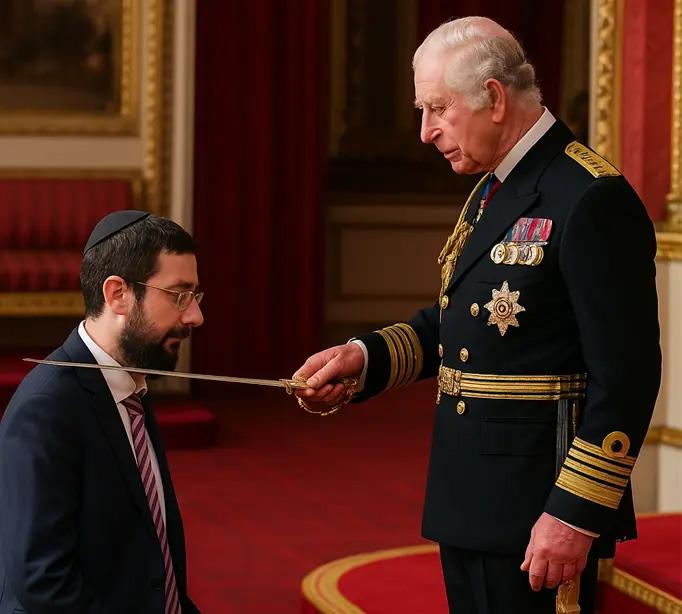
Today, our lives are so full of fake content, and it’s getting to the point that we can’t tell anymore what is real and what is not. My social media feed is full of fantastical stories and incredible pictures of either underground or underwater locations. I read the rivetinG-descriptions and go to Google to discover that such places do not exist.
It’s so easy to fake everything: fake people’s voices, fake their images or videos and stories. So, IMHO, our times truly deserve to be called The Fake Era.
Now, let’s not blame ChatGPT for it all. We have been lied to for a very long time. All the people on the billboards have been meticulously airbrushed to look beautiful; cars have been carefully designed to make us desire them; and don’t get me started about movies, which are so often filmed with a dull green screen to be made to look incredible using CGI effects.
In the book of Ecclesiastes, King Solomon declares: Van-
The song’s lyrics are both in Hebrew and Yiddish, and it begins with the words, S’iz doch altz hevel havolim, isn’t it all vanity of vanities.”
Now, you might think that such a song will have a slower, reflective, and perhaps sad tune to go along with it. But the opposite is true. This song has a lively tune, full of energy and joy. How is that possible? Because it ends with the powerful statement: Ein od milvado, “there is nothing but Him.”
The Jew is singing and dancing because while he realizes the fake world, he also celebrates his connection to G-d, the eternal truth.
The Jew is happy because realizing how everything is nothing makes him discover the Actual Something.
And when we realize how “Something” everything is and how ein od milvado, there is nothing but G-d, something incredible happens. We approach the world with a whole new perspective. We no longer look at our materialistic world as a conflict with spirituality. Instead, we see the true and holy purpose of everything.
So there you have it. Living in the Fake Era can bring us tremendous benefits: the constant stream of fakeness will remind us to connect with the actual reality, to learn more Torah, to do more mitzvot, and to remember that everything - that big, fake everything - is really something, all created to serve the holy purpose for which we were created.

Shavuot Holiday Guide 5785 - 2025
Be There With Your Children
This year, on Monday, June 2, in synagogues across the world, the Jewish people will stand together once again to experience the Giving of the Torah with the reading of the Ten Commandments. Wherever you are, you are invited to take part - just as you did 3337 years ago.
Our Sages recount that when the Jewish people came to receive the Torah, G-d asked for guarantors. They offered every responsible party they could imagine, but G-d was not satisfied; until they declared, “Our children will be our guarantors!”
So make sure to bring along your guarantors - the children, right down to the newest sponsors - when you come to hear the reading of the Ten Commandments at the Giving of the Torah on Shavuot.
Shavuot Calendar
Times are for the Rochester area only
Sunday, June 1:
Light the Yom Tov candles at 8:26 p.m. and recite blessings.
Tikun Lail Shavuot during the night.
Monday, June 2:
Attend services in the morning to hear the reading of the Ten Commandments.
Light the Yom Tov candles from a pre-existing flame* after 9:37 p.m. and recite blessings.
Tuesday, June 3: Yizkor is recited during services. Shavuot ends at 9:38 p.m.
*A pre-existing flame is a flame burning continuously since the onset of the Shabbat such as a pilot light, gas or candle flame.
BLESSINGS FOR CANDLE LIGHTING
Boruch A-toh Ado-noi E-lo-hei-nu Me-lech Ho-olom A-sher Ki-de-sho-nu Be-mitz-vo-sov Ve-tzi-vo-nu Lehad-lik Ner Shel Yom Tov.
Bo-ruch A-to Ado-noi E-lo-hei-nu Me-lech Ho-olom She-heh-che-yoh-nu Vi-ki-ye-mo-nu Ve-he-ge-o-nu Liz-man Ha-zeh.
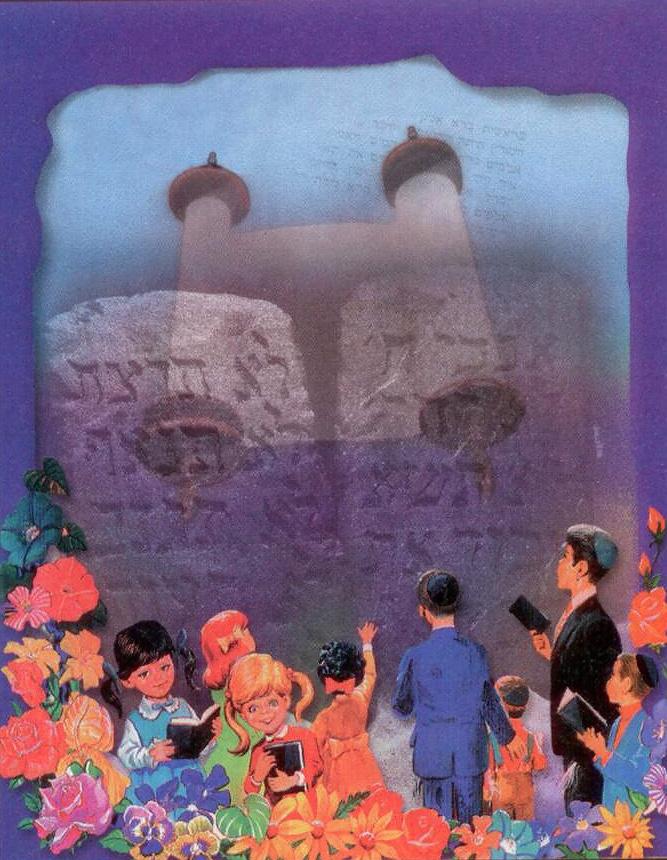
The Holiday of Shavuot
Shavuot is the second of the three major Jewish festivals, (the others are Passover and Sukkot) commemorating the giving of the Torah at Mount Sinai 3330 years ago. Shavuot marks the beginning of the Jewish people as a nation. It is the time when G-d pronounced the Israelites as His “chosen people” and “a holy nation”.
The Torah was given seven weeks after the exodus from Egypt, and is considered the culmination of the “birth” of the Jewish people, which began at the exodus on Passover.
The word Shavuot means weeks, for it marks the completion of the seven weeks between Passover and Shavuot during which the Jewish people were extremely eager, counted the days and prepared themselves for the giving of the Torah. During this time they cleansed themselves of the scars of slavery and became ready to enter into an eternal covenant with G-d with the giving of the Torah.
Now, too, as commanded in the Torah, we count the 49 days between the first day of Passover and the festival of Shavuot.
Shavuot also means “oaths”. The name indicates the oaths which G-d and Israel exchanged on the day of the giving of the Torah to remain faithful to each other forever.
The Torah is the very essence of the Jewish people. It is our way of life and the secret of our freedom, our nationhood and our existence. Even before the redemption from Egyptian bondage, G-d told Moses that He would redeem the Jewish people in order that they would receive the Torah. For there can be no true sovereignty for a Jew without Torah.
At Mount Sinai, the entire Jewish nation, millions of men, women and children, witnessed the revelation of G-d as He spoke the words of the Ten Commandments. It is this event, the revelation of G-d Himself, without a mediator,
that established for all of the people, the truth and eternity of the Torah.
After the Giving of the Ten Commandments, Moses ascended to the peak of Mount Sinai, and stayed there for forty days and nights. During this time, G-d taught him the entire Torah, as well as the principles of its interpretation for all time. He also gave him the two precious stone tablets, in which He engraved the Ten Commandments.
Upon his descent, Moses taught the Torah to the Jewish people. The Torah was then taught and transmitted from generation to generation, until this very day.
What is the Torah?
The word “Torah” means instruction or guide. The Torah is composed of two parts: the Written Law and the Oral Law. The written Torah contains the Five Books of Moses, the Prophets and the Writings. Together with the Written Torah, Moses was also given the Oral Law, which explains and clarifies the Written law, much like a constitution and its bylaws. It was transmitted orally from generation to generation and eventually transcribed in the Talmud and Midrash.

The Torah & Its Commandments
The Torah relates how G-d created the universe, how the human race came into being from Adam and Eve, how our Fathers, Abraham, Isaac and Jacob fared, how the Jewish people became a nation, chosen by G-d to be ‘a kingdom of priests and a holy nation’ through receiving and observing the Torah. The Torah contains 613 commandments, of which 248 are positive (what to do) and 365 are negative (what not to do). Masorah (Tradition) In addition to the precepts, commandments and prohibitions written in the Torah, G-d taught Moses more laws, which he was to memorize and orally convey to his successors, who in turn were to uphold this tradition from generation to generation. Many laws and customs have thus been practiced by us traditionally, as if they were actually written in the Torah.
The Prophets
Following the passing of Moses, as G-d promised, He revealed himself to individuals of great piety and spirituality. These are the prophets who recorded G-d’s instruction and messages. In all there are 19 books of the prophets. In all we had 48 prophets and 7 prophetesses whose prophecies were recorded for their everlasting importance.
The Holy Writings
These include the books like Psalms, Song of Songs, Ruth and Esther, 11 in all. All of which were written by one or another of our prophets by divine inspiration (“Ruach Hakodesh”)
The Revealed & Hidden Parts of the Torah
The Torah in its origin and essence is Gd’s infinite wisdom and will. And it is the infinite G-dly wisdom that is concentrated in the human logic and practical laws of the Torah addressing mundane worldly matters.
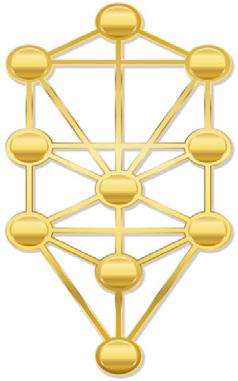
The Torah, as it deals with practical laws, is the revealed part of the Torah. The internal and mystical element of the Torah, focuses on the G-dly dimension of the Torah and mystical significance of the Mitzvos, which are the teachings of Kabbalah and Chassidut. They are, as referred to in Jewish tradition, the neshama (the soul) and essence of the Torah. Both the hidden and revealed are inseparable parts of the Torah, received from Sinai and transmitted from generation to generation throughout our history.
The Mitzvot

There are 613 Divine commandments embracing every facet of our lives, both the duties to fellow man and the way to worship G-d. The positive commandments, numbering 248, equal the number of organs in the human body, implying that a person should serve the Creator with every part of his being.
The 365 negative commandments are equivalent to the number of blood vessels in the human body, indicating that when we guard ourselves from transgressing these prohibitions, as we might be tempted to do by desires inherent in the blood, each one of our blood vessels, remains “unblemished” and pure. The negative commandments also equal the number of the 365 days of the year.
The Significance of Mitzvot
Mitzvah literally means commandment. However, it also means companionship (from the Aramaic tzavta - companionship). Upon fulfilling a commandment one becomes united with G-d, who ordained that precept. For, regardless of the nature of the commandment, the fulfillment of G-d’s desire, creates a relationship between the creator and the human who executed it. By fulfilling His wish a person accomplishes an infinite purpose and is in G-d’s “company”.
This is the interpretation of our sages’ statement (Avos
The Chabad Times - Rochester NY - Sivan 5785 4:2) “the reward of a mitzvah is the mitzvah”, indicating that the mitzvah itself is the greatest reward, for this sets us in a companionship with the eternal and infinite G-d. All other rewards are secondary in comparison to this great merit.
From Our Tradition - The Giving Of The Torah Kesser - A Crown

The Ten Commandments consist of 620 letters, equaling the number of the 613 Mitzvos and the 7 Rabbinical Mitzvos (such as Chanukah, Purim, etc.). 620 is the numerical value of the Hebrew word “Kesser”- a crown. Each mitzvah is considered a part of G-d’s crown. When fulfilling a mitzvah a person offers a crown to the Almighty.
The Lowest Mountain
We all know that the Ten Commandments were given on Mount Sinai. Why Sinai? Say the Sages: Sinai is the lowest of all mountains, to show that humility is an essential prerequisite to receiving the Torah.
Why then on a mountain? Why not in a plain - or a valley? The Code of Jewish Law states at the very beginning: “Do not be embarrassed by mockery and ridicule.” For to receive the Torah you must be low; but to keep it, sometimes you must be a mountain.
Purpose Of The Torah
The Midrash relates that when G-d was about to give the Torah the heavenly angels argued that He should offer it to them. Upon G-d’s request Moses replied, “Have you been in Egypt? Do you have an evil inclination?

This implies that the Torah was given in order to elevate humanity as well as the world in general. Precisely for those who have an evil inclination and need to be refined, was the Torah given.
“Na’aseh V’Nishmah”
Our sages relate that when G-d was about to give the Torah, He offered it first to all of the nations of the world. After inquiring what was written in it, each of them found in the Torah something not agreeable to their system and way of life. When He offered the Torah to the Jewish people, without even asking what it contained, they immediately exclaimed, “We will do and listen.” This uncon-
ditional devotion and acceptance of G-d’s law, prompted G-d to give them the Torah.
A Triple Torah
Everything connected with the giving of the Torah was of a triple nature: the Torah consists of Chumash (the five books), Prophets, and the Holy Writing (TaNaCH). It was given to Israel, comprised of Kohanim (priests), Levites and Israelites, through Moses, the third child in the family, after three days of preparation, in the third month (Sivan).
Three Knots
The Zohar declares “three are interlocked together: Israel, the Torah, the Holy One, blessed be He.”
49 Days Of Counting
Upon their leaving Egypt, when Moses related to the Jewish people that G-d will give them the Torah, the Jewish people were extremely eager and impatiently counted the days. Hence the Mitzvah of counting the 49 days between Pesach and Shavuot.
As One Person, With One Heart
Our Sages relate, that when the Jews camped before Mount Sinai, they were “as one man, with one heart”. Many of their other journeys were characterized by differences of opinion and even strife. However, when they prepared to receive the Torah, the Jews joined together with a feeling of unity and harmony. This oneness was a necessary prerequisite to the giving of the Torah.
Sight and Sound
The Book of Exodus relates that when G-d gave us the Torah at Mount Sinai, “The people saw the voices.” “They saw what is ordinarily heard,” remark our sages, “and they heard what is ordinarily seen.”
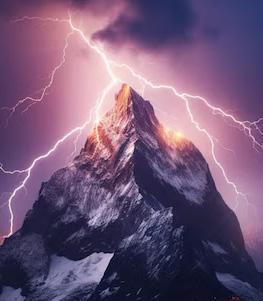
As physical beings, we “see” physical reality. On the other hand, G-dliness and spirituality is only something that is “heard”—it can be discussed, perhaps even understood to some extent, but not experienced first hand.
But at the revelation at Sinai, we “saw what is ordinarily heard” – we experienced the Divine as an immediate, tangible reality. On the other hand, what is ordinarily “seen” – the material world – was something merely “heard”, to be accepted or rejected at will.
Tikun Lail Shavuot
On the first night of Shavuot, it is customary to stay up all night and study Torah. Our sages relate that on the night of Shavuot the Jewish people went to sleep, in preparation to receiving of the Torah. At day break, when G-d appeared to give the Torah they were sleeping. In contrast, we now prepare ourselves by studying Torah all night, ready to “receive the Torah” once more when G-d again offers us the Torah with renewed vigor.
Dairy Foods & Blintzes
It is customary to eat dairy products on Shavuot. A number of reasons have been given for this custom. Among them: the Torah is compared to milk. Also on Shavuot, immediately after receiving the Torah, the Jewish people were required to eat kosher. The only foods available for immediate consumption were milk products.
The custom to eat cheese blintzes on Shavuot is based on a play of Hebrew words. The Hebrew word for cheese is Gevinah, reminding us of the “controversy” of the taller mountains, each claiming to be worthier than Sinai for the privilege of receiving the Torah. They were therefore called Gavnunim - “humps,” because of their conceit, while Sinai, small and humble, was chosen for its humility.
Ruth
Yizkor
On the second day of Shavuot the Yizkor memorial service is recited

Additional Names of Shavuot
Shavuot is also called Atzeret, meaning The Completion, because together with Passover it forms the completion of a unit. We gained our freedom on Passover in order to receive the Torah on Shavuot.
Another name for Shavuot is Yon Habikurim or the Day of the First Fruits. In an expression of thanks to G-d, beginning on Shavuot, each farmer in the Land of Israel brought to the Temple the first wheat, barley, grapes, figs, pomegranates, olives and dates that grew in his field.
Finally, Shavuot is also called Chag HaKatzir, the Festival of the Harvest, because wheat, the last of the grains to be ready to be cut, was harvested at this time of the year. On Shavuot two loaves of wheat bread from the new harvest were offered at the temple in Jerusalem.
Cheese Blintzes
Batter:
• 4 eggs
• 1 cup milk
• 1 cup flour
• 1 Tbsp. sour cream
Filling:
• 16 ounces cottage cheese
• 2 egg yolks
• 2 Tbsps. margarine or butter, melted

In many synagogues the book of Ruth is read on the second day of Shavuot. There are several reasons for this custom: A) Shavuot is the birthday and yahrzeit (day of passing) of KinG-david, and the book of Ruth records his ancestry. Boaz and Ruth were KinG-david’s great grandparents. B) The scenes of harvesting, described in the book of Ruth, are appropriate to the Festival of Harvest. C) Ruth was a sincere convert who embraced Judaism with all her heart. On Shavuot all Jews were converts having unconditionally accepted the Torah and all of its precepts.
Fruits, Flowers & Greens
It is customary on Shavuot to adorn the synagogue and home with fruits, greens and flowers. The reason: FruitsIn the time of the Temple the first fruits of harvest were brought to the Temple beginning on Shavuot. GreensOur Sages taught that on Shavuot judgment is rendered regarding the trees of the field. Flowers - Our Sages taught that although Mount Sinai was situated in a desert, in honor of the Torah, the desert bloomed and sprouted flowers.
• 1/4 cup sugar
• 1 package vanilla sugar
• pinch of salt
• 2 Tbsps. sugar
• 1/4 cup raisins (optional)
• 1/3 cup oil for frying
Cheese blintzes are a special favorite on Shavuot when it is customary to eat a dairy meal. They are served hot, with sour cream or applesauce.
Batter: Combine eggs and milk. Add sour cream and blend well. Add flour gradually. Mix well until batter is smooth. Heat on a low flame a small amount of oil in an 8 inch frying pan, until hot but not smoking. Ladle a small amount of batter (approx. 1 ounce) into pan, tipping pan in all directions until batter covers the entire bottom of the pan. Fry one side until set and golden, (approx. 1 minute). Slip pancake out of pan and repeat until all batter is used. Add oil to pan as necessary.
Filling: In another bowl mix all ingredients for filling. Fill each pancake on golden side with 3 Tbsps. of filling. Fold in sides to center and roll until completely closed. Replace rolled blintzes in pan and fry for 2 minutes, turning once.
How I Found G-d in a Terror Tunnel
Sasha Troufanov, Former Gaza Hostage
“I had almost no control over anything,” shared former hostage Sasha Troufanov. “Many times, my life was in danger, and I felt despairing. I could have surrendered to the despair and collapsed, overwhelmed by negative emotions. But each time, just before I imploded, something would happen to pull me back from the edge.
“And I mean even simple things. For example, one day when I was truly starving and desperate for food, suddenly, later that day, relatively decent food arrived. “Decent food” doesn’t mean a meal, but food that at least left me not hungry after eating it. Maybe rice, or tomatoes and onions, or some beans.”
In a lengthy Hebrew interview with Kfar Chabad Magazine’s Mendy Kurtz, Troufanov openly discussed how he discovered G-d in Gaza.
“So often, just when I was feelinGdeeply depressed, something would occur that improved my mood, and over time, the understanding gradually settled in me that something beyond my control was influencing me. That’s how I came to believe in G-d, and to understand that not everything is in my control.”
This is the very reason he agreed to be interviewed, he explained.
much larger than it is today - I was more muscular and sturdy. I’ve always loved fitness. They thought I was a fighter, a Rambo, and it would have been natural for them to tie me up and not let me move. But because of my injuries, they didn’t shackle me. But that’s only the first part.

I want people to thank G-d for what they have. I want whoever reads my words to feel positive about their own life. When a person feels good in their heart, it’s good for others too, for their surroundings. It radiates.
“I want people to thank G-d for what they have. I want whoever reads my words to feel positive about their own life. When a person feels good in their heart, it’s good for others too, for their surroundings. It radiates.”
He also revealed how he learned Arabic in captivity. “During the abduction, they shot me in the leg. I’m sure anyone who gets shot in the leg would cry about it, complain, and say, ‘How bitter and cruel is my fate.’ And I can tell you: it really isn’t pleasant … The bullet shattered my bone - I had a complete fracture. I was treated there in Gaza. But because of that, good things happened.
“First, the reason they didn’t shackle me was that I was a physical wreck at that point. I had a stab wound in my shoulder, an open head injury, and gunshot wounds to my legs. Later, my shoulder was also dislocated. Luckily, this made them treat me more gently. On the surface, it shouldn’t have been that way. They thought I was a military officer. When I was abducted, my physical build was
“Later, they transferred me to a medical center for treatment. There was no other choice, but it took some time. Afterwards, they wanted to return me to the same place I was initially held. But something happened - things didn’t work out - so they moved me temporarily to another place in Gaza. There, there was a new terrorist who also spoke English. Thanks to him, I learned Arabic. I would ask him how to say various words in Arabic, and from him, I learned. Slowly, I built up a basic vocabulary that allowed me to communicate in Arabic and develop the language. In captivity, you think fast. You learn a language in an instant - your brain works at 200%.
“For about 40 days, I was in the new place with the English speaker. After that, they took me elsewhere, and from then until almost the end of my captivity, I didn’t meet anyone else who spoke English like him. It was my luck that I met him. And it happened because I was shot in the leg.”
About his first moments in Gaza, Troufanov recalled: “Those are the moments I remember most - the realization of where I was. The shift from the life I was used to was absolutely total - from the smell in Gaza to, of course, the horrible conditions they put me in. I was abducted alone and was beaten during the abduction. I arrived physically bruised and broken.
“At first, they took me to a house, which was actually a shack. The people there were so different from the kind of people I was used to seeing. Over time, I understood where I was. The food in the first days was relatively decent, but very quickly, it became one portion a day. It took time to get used to not having everything I was accustomed to, to needing permission for everything. Even to go to the bathroom, I had to get approval. Sleep hours were also determined for me. Like prison - but much worse.
“I realized I had to remember that I was still mentally a free person and that I needed to try to find freedom
the places where I did have a choice. I loved playing with the food I was given. I would eat some and save some for later. Even if it wasn’t much. That way, I felt like I was the one makinG-decisions. I tried to turn the lack of choice into choice.”
This year, Troufanov celebrated Passover with his family in Moscow. “We’re celebrating in the best possible place - as guests of Rabbi Berel Lazar, the Chief Rabbi of Russia. He invited the whole family and wanted us to come. I’ve never celebrated a Jewish holiday before. Honestly, it’s very exciting.
“When I saw Rabbi Lazar the day after my release, what stood out most was his kindness. It’s very present, radiating from him. He’s a very pleasant and warm person, and he’s not afraid of tough questions. When he helped me put on tefillin, I asked him several questions about them, and he answered, saying it was good that I was asking and showing interest. It struck me: until then, I thought religious people didn’t like being asked questions - be-
SCAN QR
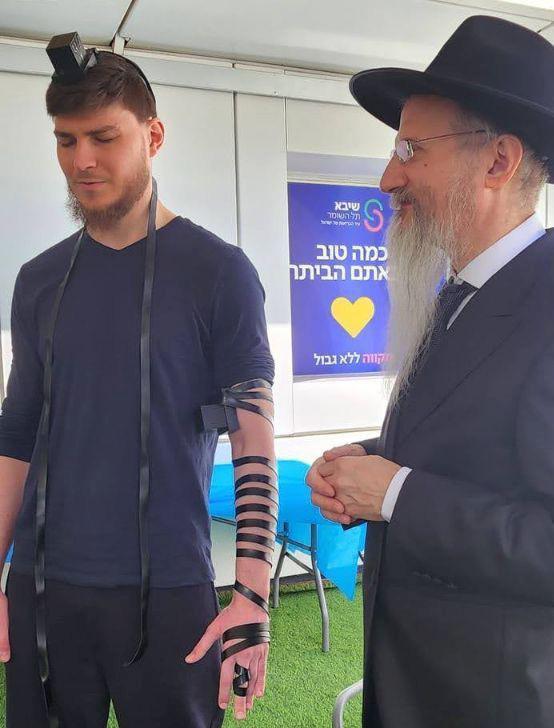
cause to me, religion was based on pure faith and avoiding questions. I thought the more religious people were, the less they accepted the other side. But with Rabbi Lazar, it was exactly the opposite. I received so much acceptance, warmth, and love.
“Passover symbolizes the Exodus from Egypt. I didn’t come out of Egypt; I wasn’t in slavery. I was a hostage - I don’t know what to call it. But it’s certainly a holiday that symbolizes freedom and the ability to choose and focus on things that concern you and no one else. Now, I was granted the ability to choose for myself where to celebrate the holiday this year and with whom.
At the same time, Troufanov says he cannot forget those who are still in Gaza. “Although I’ve received my freedom, in some ways, I still feel shackled - not physically - to that place. I think everyone can understand and would feel the same way if their friend was still there in captivity.”
Translated with permission from Kfar Chabad Magazine.
CODE FOR TEHILLIM - PSALMS FOR OUR BROTHERS & SISTERS IN ISRAEL
FOR THE IMMEDIATE RELEASE OF THE HOSTAGES FOR THE SAFETY OF THE SOLDIERS
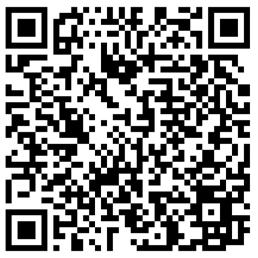

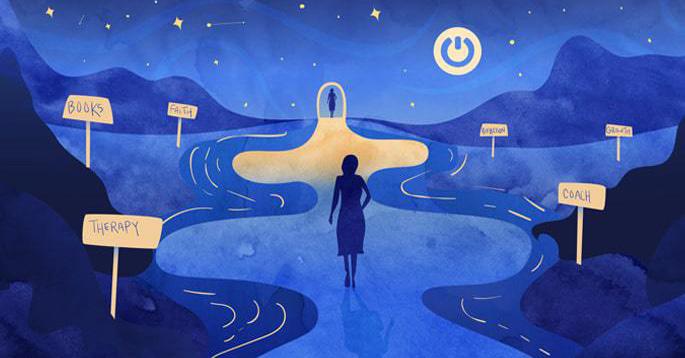
The Book of Your Life
When seeking to discover our life’s purpose, it is common to look for direction outside of ourselves.
Whether it be from teachers, gurus, therapists, life coaches, educational institutions, or wisdom traditions, most people seek external guidance hoping to make sense of the presumably random circumstances of their lives so they can actualize their dormant potential.
And while various forms of external guidance do indeed have a role to play in the story of our lives, the principle of specific Divine Providence, as elucidated by the Baal Shem Tov, teaches that the greatest indicators of our life’s purpose are embedded and can be found in our inner world, composition, and makeup. Hence, the greatest guide to seeking and finding our purpose in life is our own Divine design.
This was the fundamental philosophy set out by the Previous Rebbe, R. Yosef Yitzchak Schneersohn, in a letter to young Eliyahu Tzvi Einbinder as he set out in search of his purpose in life:
“The Torah states: These are the offspring of Adam. [The Hebrew term for] Toldot Adam, offspring, can also be read as life story - the life story of a person is a book that he must study. That book must be a guide for the person’s life.
“Toldot adam can also be translated as a person’s birth. Here it means:
1. The purpose for which this person was born into this world;
2. to whom this person was born;
3. in which place this person was born;
4. in what era this person was born;
5. what kind of training (upbringing) and education this
person had;
by Mendel Kalmenson
6. the kind of environment in which this person grew up;
7. which talents this person has;
8. what kind of natural character traits one has;
9. what kind of hobbies and interests one has;
10. the Divine Providence that guided the person until he became self-directed and took a stand in life.
“Taken together, these ten things compose the life of a person. They form a book that the person must study and then choose to follow in all of their affairs, both in their relationship with G-d and in their relationship with other people.”1
This ten-point guide provides a comprehensive framework for discerning how each part of your inner world and personal circumstances are Divinely imparted to help you identify and fulfill your mission in life.
The Golden Rule
According to the mystics, every single aspect of creation is crafted and guided by the Hand of G-d for a reason. This monumental notion is a cornerstone of Chassidic thought, as introduced and elucidated by the Baal Shem Tov, who sparked a revolution in thinking about G-d’s immanent involvement in creation. This foundational principle is what we might refer to as the “Golden Rule” of spiritual perception and consciousness - in Hebrew Hashgachah Pratit, which translates as Specific Divine Providence or synchronicity.
The Torah teaches that G-d not only created the world but that He continues to direct it throughout all time. G-d is therefore referred to both as “the Creator” and “the Director” of the world. In the Book of Ezekiel, for example,
the prophet passionately decries those who think that G-d has left the world to its own devices and is no longer intimately involved in its everyday unfolding.
Maintaining this interconnected big picture view of life is an avodah, spiritual labor, in and of itself. Indeed, we find numerous times throughout the ages when this perspective is submerged beneath other philosophical streams that seek to limit the scope of the Creator’s involvement with creation. In dialectical fashion, such periods of hester panim, the obscuring of G-d’s presence, are inevitably rebalanced by an eruption of mystical consciousness and spiritual renaissance-revealing G-d’s Face and Hand where it had been previously imperceivable.
In the case of the Chassidic revolution, beginning in the eighteenth century, it was the Baal Shem Tov who insisted that G-d’s Providence guides every single detail of creation, not just human life. In the illuminated eyes of the Baal Shem Tov, even a single drop of rain is part of the master plan of creation.
As elucidated by the Previous Rebbe: “The Baal Shem Tov taught us the [deeper] meaning of Hashgachah Pratit: Not only are all the detailed movements of each creation governed by G-d’s Providence, and this [Hashgachah Pratit] is actually their very source of life, but every move of each individual creation has a place in the larger story of the entire creation…”3
chestrated dance of creation, even if we fail to recognize it.
Divine By Design
Through this lens, the book of your life emerges from the unique aspects of your Divine design. Indeed, each and every one of us is constructed quite precisely. Not just certain parts of us but our entirety. Even what you may perceive as flaws and imperfections are in their own way perfectly imperfect features of your existence, because they were written into your life by the Hand of G-d. This is true no matter how small, simple, disconnected, or randomly appointed these characteristics may appear at first glance. By looking inward and reflecting on your inner makeup, natural gravitations, and dispositions, as well as your personality, character, passions, natural gifts, talents, and even vices and struggles, you will find that you have a host of internal indicators that become clues and tools to help you discover and fulfill your Divine purpose. This is equally true of the various circumstances, events, people, places, and challenges that occur throughout your life.
Even what you may perceive as flaws and imperfections are in their own way perfectly imperfect features of your existence, because they were written into your life by the Hand of G-d.
The delicate specificity of G-d’s involvement in creation is highlighted in a moving story of the Baal Shem Tov. As he walked through the forest with some of his students, he drew the attention of his students to a single leaf that had blown off a tree and floated down to rest in front of them on the pathway. He related that this particular leaf had fallen from that exact tree, precisely at that moment, because it had been so orchestrated by G-d.
He then asked one of one of his students to lift the leaf, which he did, discovering a worm that had lain suffering in the summer sun. The fallen leaf was the answer to the worm’s prayers, providing it shade from the sun.
Here, the Baal Shem Tov connects the seemingly random, unrelated dots of circumstance to reveal a stunning constellation of Divine Providence encompassing every aspect of creation - the path of a falling leaf, the wind that loosed it from its branch, the worm that it fell to protect, and the journey of the students, whose precisely-timed arrival presented an opportunity for a demonstration of G-d’s will at work in the world. Each aspect, guided by G-d, is a precious part of a greater wholeness, with each contributing something crucial and indispensable to the larger story. From this integral perspective, everything has a purpose, and every purpose is part of the perfectly or-
Through the kaleidoscopic lens of Chassidic teaching, we begin to see the world as more than just a random place of indifference, or as Joseph Heller described it, “a trashbag of coincidences blown open by the wind.” Rather, Hashgachah Pratit consciousness reveals the world and history to be a convergence of subtle orchestrations and gentle nudgings arranged to help us discover the higher purpose in every moment, event, and encounter in our lives. This elevated and elevating perspective reveals to us that, in fact, there is a Divine plot that informs our human storyline, and our purpose is realized at the intersection of Divine Providence and human initiative.
With this in mind, the circumstances of our lives begin to shine in a new way. In telling stories about how you met and married your spouse, for example, you may emphasize that you were drawn by their sense of humor, beauty, intelligence, or note that you met by chance at your favorite coffee shop one afternoon. And while all of that may be true, there is a deeper truth to be found in the qualities and circumstances that brought you together. This is the truth of Divine Providence - that your appreciation of blue eyes and a good sense of humor, and your gravitation toward the coffee shop where you would eventually meet, were written into the book of your life as plot devices in the story of your unfoldinG-divine purpose.
Whatever the details or circumstances, awareness of Divine Providence emphatically asserts that no part of us, nor anything that happens to us, is superficial or inconsequential. Of course, we are always free to choose how to react to our external circumstances and natural disposi-
The Chabad Times - Rochester NY - Sivan 5785 tions - what we make of and from them. But the raw materials, as it were, were given to us by G-d and arranged by Divine design.
A Task Done Well
The circumstances we are born into and encounter throughout our lives are preordained and are all perfectly coordinated and choreographed to create the conditions for us to achieve our ultimate purpose.
As the Rebbe taught: “Whoever has faith in individual Divine Providence knows that “Man’s steps are established by G-d” - that this particular soul must purify and improve something specific in a particular place. For centuries, or even since the world’s creation, that which needs purification or improvement waits for this soul to come and purify or improve it. The soul, too, has been waiting - ever since it came into being - for its time to descend, so that it can discharge the tasks of purification and improvement assigned to it.”
Indeed, for each of us, somewhere out there is a marriage of soul and circumstance waiting for us to intercede.
prayer, immersion in a mikveh, or having a drink of water that is preceded and followed by words of thanksgiving to its Maker.
“Near the place where I sent you, there was a fountain that had been weeping for five thousand, five hundred nineteen years - since the creation of the world: Why should it be less than all the other fountains in the world? Why should its waters be denied their elevation? Since the Holy One, Blessed Be He, created it, no one had ever made a blessing over its waters, and they had never been used for holy purposes. That day, when you blessed then drank its water and used it to wash your hands for prayer, you elevated that fountain. This was all the working of Divine Providence. Every creature and creation has a time for its elevation, and it is preordained when it will occur and by whom. And that is true for each and every soul; it, too, has its time for elevation.”

This was the lesson sent in a letter by the Baal Shem Tov to his disciple, the great scholar R. Chaim Rapaport, who was instructed to travel to a specific place in the forest outside the city and study Torah there in depth, recite afternoon prayers, and then return home. Despite not knowing the purpose behind the numerous instructions, the disciple followed them, traveling to the forest to begin his studies. After studying for a while, R. Rapaport became very thirsty and sent his companions to search for water. While searching amid the forest undergrowth, they discovered a fountain that provided fresh water, which they brought back to relieve the rabbi’s thirst. After drinking, he also used the water to wash his hands before praying, after which they all returned home.
Indeed, for each of us, somewhere out there is a marriage of soul and circumstance waiting for us to intercede.
The insistence that everything in the world is part of G-d’s Providence was a cornerstone of the Rebbe’s teachings, and it inspired him to constantly repeat the teaching of the Baal Shem Tov that everything a Jew sees or hears must serve as a lesson in one’s service of G-d. As the Rebbe once wrote, “I have grown accustomed to searching for the Hashgachah Pratit in every opportunity.”
Recognizing Hashgachah Pratit at every step of our lives unlocks abundant opportunities to live better, more productive, purposeful, and optimistic lives. By following the threads with which we are woven into creation, we find a wholeness and sense of fulfillment that no other pursuit can provide.
Soon after, the rabbi visited the Baal Shem Tov and told him that ever since returning from that forest, his eyes and heart had been opened in Torah study and the service of G-d like never before. He thanked his teacher for sending him there.
The next Shabbat, during a meal attended by his close disciples, the Baal Shem Tov addressed R. Chaim, saying, “With G-d’s help, you succeeded in your holy task, [and] with this journey, a very significant mission was accomplished! It is written in the holy Zohar that ever since G-d separated the lower waters from the upper waters on the second day of creation, the lower waters have been weeping and begging to appear before the Holy King, that they be used for holy purposes, such as hand washing before
No matter where you are in your life, from the lowest lows to the highest highs, G-d is there, guiding you and everything that surrounds you with Divine precision and loving intention. By choosing to view life through this clarifying lens, you are positioned to both read and write the Book of Your Life, borne by a stream of perpetual grace that is carrying you and everything else toward ultimate fulfillment and completion. Indeed, start right where you are. In all likelihood, it is exactly where you are supposed to be.
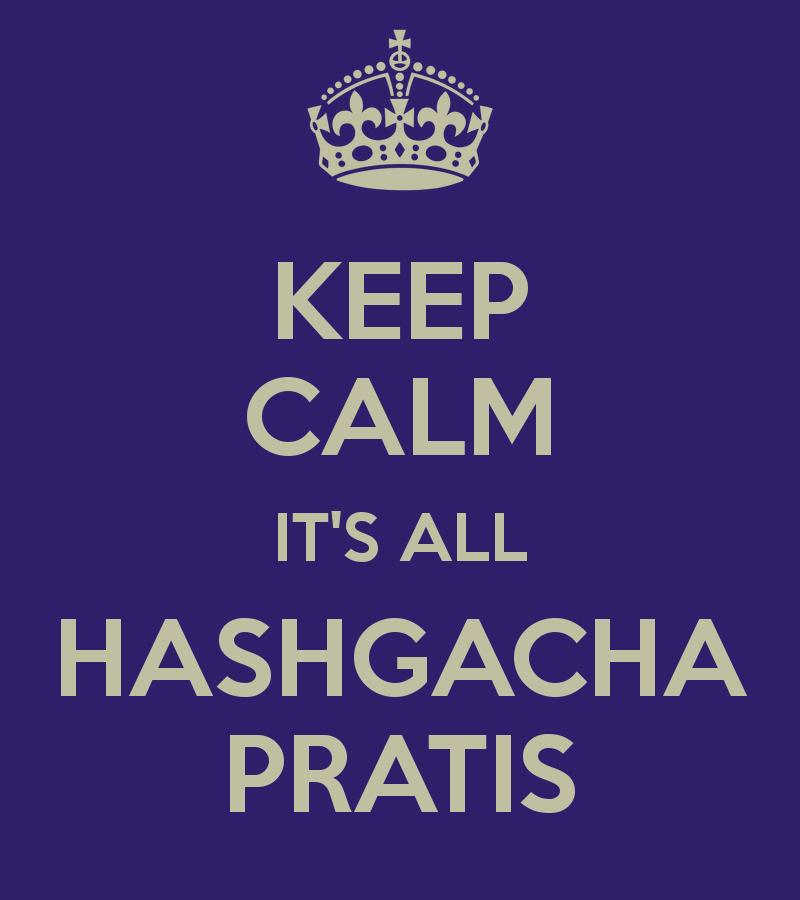
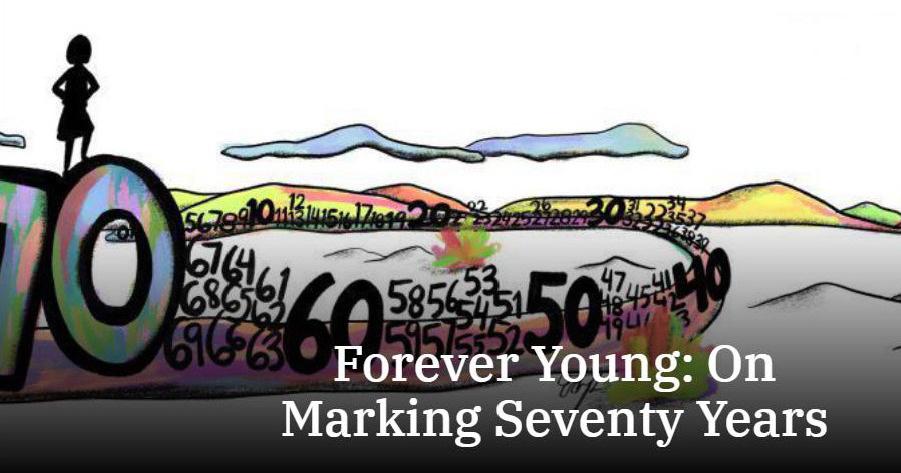
“Five years is the age for the study of Scripture. Ten, for the study of Mishnah. Thirteen, for the obligation to observe the mitzvot. Fifteen, for the study of Talmud. Eighteen, for marriage. Twenty, to pursue [a livelihood]. Thirty, for strength. Forty, for understanding. Fifty, for counsel. Sixty, for sagacity. Seventy, for elderliness. Eighty, for power….” -Ethics Of Our Fathers, 5:22
Yes, it’s happened to me. Like so many other baby boomers, I have turned seventy. Born after World War II, we came of age in the turbulent 1960s. We rebelled socially, politically, and religiously. “Don’t trust anyone over thirty,” was one of our famous mantras. Bob Dylan - one of us - expressed it well in his 70’s song, “Forever Young.” But we didn’t stay forever young. We reached thirty, then forty, fifty, sixty, and now we are in our seventies. Over the last few years, I have found myself looking around at my peers and wondering: who are all these gray-haired people, with their wrinkled necks? How can these be my contemporaries?
As my seventieth birthday approached last October, I was anxious. “It’s just a number,” friends said. But I knew deep down that it was far more. To attain that age in good health would be a blessing from G-d, but where I was heading? Was I really becoming “elderly”? Was I at the threshold of “old age”? The famous line in the book of Psalms (90:10) decrees, “Seventy years is the span of our life, and, given the strength, eighty years.” Not comforting.
I had faced another milestone the previous year: retirement. Israel requires that university professors retire at age sixty-nine. But I still had so much to give. I felt frustrated and even a bit insulted. “We are going to miss you so much, and don’t know what we’ll do without you,” my
by Susan Handelman Ph.D.
colleagues and students said emotionally at farewell ceremonies. I knew they meant it, but I also knew that everybody adjusts quickly. After a year or so, they’re not really missing you so much, and in fact, they are getting along quite well without you.
With my formal academic career concluding, who would I now become? What would I do? As a follower of the Rebbe, I had received many blessings from him during my career. He strongly encouraged me to use my G-d-given abilities and academic position for - as he put it - “special success in spreading Yiddishkeit.” Of course, the Rebbe continually impressed upon every Jew - whether child, businessman, artist, taxi driver or advanced Torah scholar - that she or he was a messenger and emissary of G-d, at every moment, in every situation, and every stage of life. How could I explain that to all of these well-meaning people who told me, “Now you’re retiring; this is your time to have fun, enjoy yourself, and do whatever you want!” They gave me blank looks when I tried.
I felt the need to expand, breathe, fly in new ways. So I interviewed retired friends, asking: How did you do it? How does it feel? What advice can you give me? “Well,” most of them responded, “you just have to try different things and see.” I was still in the dark.
Lurking behind my search, I confess, was also the deep fear that all of us who retire and move into our seventies, eighties, and nineties face: irrelevance as well as gradual physical and mental decline. In the last few decades, thankfully, there’s been an explosion of scientific research on aging, which has revealed the creativity, richness, and neuroplasticity of the older brain - just in time for us baby boomers, the first generation in history to have a good
20 The Chabad Times - Rochester NY - Sivan 5785 chance at living well for another thirty years.
So what’s everybody doing with all that new time? Retired friends pursue options like traveling to exotic places, volunteering, joining a choir, a book club, a health club, spending time with grandchildren, taking a class at a local community center. All of those are worthy and enhancing for the mind and body, but what about my soul? The Rebbe’s words about each Jew being an emissary of G-d in the world, at every moment and at every stage of life, were shadowing me. My deeper questions were existential and spiritual.
I thought about the Rebbe’s words again as I contemplated how to celebrate the actual day of turning seventy, which I was rather dreading. And there was a further connection: my year of turning seventy fortuitously coincided with the seventieth anniversary of the Rebbe’s having assumed leadership of the Chabad movement. What advice would he have given me? And what would he have told everyone today about how to celebrate his own special “seventieth anniversary”?
On his seventieth birthday, the Rebbe was asked whether he would now be taking it easier and slowinG-down. His answer? He intended to found seventy-one new Torah institutions in the next year, and asked his Chasidim to help. So he would not have let me off the hook. I also have to be able to “come into my days” - not just “fill my time” with a bunch of “hobbies” and activities. “Retired? What does that mean?” the Rebbe once asked someone in a private audience. There may be new situations requiring changes and adjustments, but “Retirement?!”
The Sweetness of Seiva; the Strength of Seventy
It doesn’t matter if the 70year-old person is intelligent or unlearned; religiously observant or not; non-Jew or Jew; “butcher, baker, or candlestick maker.” You are commanded to honor that life-wisdom of seiva. And for that we stand up.
So I read the transcript of the talk that he gave on his seventieth birthday in April, 1972. And here it comes: most important, he said, is to ask yourself on a birthday, “What have I done so far with all the days and years of my life since my coming into the world?” Am I like Abraham whose later years the Bible describes with the phrase “ba bayamim” (Genesis 24:1)?
That Hebrew phrase - ba bayamim - literally means “come into days.” It is often dispiritingly translated as “advanced in age” or “stricken with years.” According to the Rebbe, the Zohar interprets the phrase to mean that not one day is “missing” in your life; each one is full and meaningful.

For a while, I toyed with the idea of trying “seventy-one new things” in the year after my seventieth birthday, like touring seventy-one new places in Israel. But that felt like too much, especially since my current levels of energy and stamina aren’t what they used to be. Indeed, I have more physical aches and pains than when I was younger, do not remember names as quickly. I no longer have the patience or will to sit day and night writing academic books. At the same time, I have felt other kinds of strengths growing inside - quieter and less visible.
In mapping the stages of life, the ancient Jewish Sages said: “Sixty, for sagacity (ziknah). Seventy for elderliness (seiva).” The word ziknah, used for the decade I just leftthe sixties - is often literally translated as “old age.” The Talmud more profoundly translates ziknah as “sagacity”defining ziknah as an acronym of the Hebrew phrase “zeh shekanah chochmah” or “one who has acquired knowledge/wisdom” (Talmud, Kiddushin 32b).
But I wonder, how is the sixty-year-old’s “wisdom” different from the seventy-year-old’s “elderliness”? What has changed? Is it all downhill from here? The question arises especially when I look at the English translations of seiva and find: “hoary head”; “gray-haired”; “elderly, aged.” Me?
Another place the Torah uses the word seiva is in the well-known commandment in Leviticus 19:32: “Mipnei seiva takum v’hadarta pnei zaken,” usually translated as, “Before the elderly person you shall arise, and honor the

face of the old person.” Here in Israel, I smile when seeing the first part of that verse on stickers on public bus windows right behind the driver. “Mipnei seiva takum”: get up and give your seat to an elderly person. But now it’s started happening to me! Why all of a sudden are these young people getting up for me? Do I look old, weary, and weak? It wasn’t too long ago that I myself was giving up my seat for older people. On the other hand, I have to admit, it is a relief to get that seat.
In addition to getting relief on a crowded bus, I need to know what might be positive about seiva and what defines it. In an aside at one of my Torah classes, my longtime teacher fortuitously threw out a definition based on the words of Rabbi Yehuda Loew, the Maharal of Prague (1520-1609): up to the age of sixty-nine and including that year, you are considered ben olam ha zeh; you belong to “This World.” And when you turn seventy, you become ben olam ha ba - connected to the “Next World,” the “World to Come.” That was unsettling to hear. I wondered: Do I now have one foot out the door of this life, G-d forbid?
But then the rabbi continued. At age seventy, he said, you have amassed a huge amount of life-wisdom or “chochmat chayim.” You now see the world at large and your own personal life journey - all the twists and turns, ups and downs - with a very broad perspective. Until the age of seventy, it is not possible to have that wisdom. And that is why we rise for an “elderly” person. Mipnei seiva takum: the Bible uses only the word seiva here, he stressed, without any other descriptive adjective. It doesn’t matter if the seventy-year-old person is intelligent or unlearned; religiously observant or not; non-Jew or Jew; “butcher, baker, or candle-stick maker.” You are commanded to honor that life-wisdom of seiva. And for that we stand up.
experience, that life-wisdom is about having more equanimity when looking at the world, at others, and at myself. More acceptance, more gratitude, and more humor about it all. It’s being able to more sweetly flow with the onrushing stream of life. That’s the wisdom behind the popular contemporary Israeli slang word – zorem - “flow” - meaning the attitude you need to get you through frustrating situations. At sixty, I was still immersed in and at the peak of my academic career. At seventy, I have more distance; I feel freer from all that. “Been there, done that.” Other things seem more important than adding to my CV. I feel more the need to nurture and support the younger generation, and myself, than to compete or hang on to what my professional status was at sixty.
But then the Rebbe came to my rescue: The verse, he commented, is in fact giving you directions about what to do when you reach seventy. It’s telling you that after you complete that first seventy years, you then begin a whole new era of strength, of “gevurah.”
But I confess, it is not easy to let go, be humble, and admit my energies and interests are just not the same. It is a loss as well. Maybe that’s what the mishnah is also adding when it distinguishes between the “wisdom/elderliness” of ziknah at sixty and this seiva of seventy. It is telling us that it’s a trap if you try to stay at seventy what you were at sixty. You will get stuck; you need to flow (“zorem”).
I do feel that reservoir of life-wisdom welling up inside. It’s quite different from my academic intellect. But it, too, has been won through much toil and many tears. In my

Justin Smith Vice President Senior Branch Manager
This is the way the Book of Psalms (92:14-15) describes a person who has “flowed,” lived and aged well from age to age, stage to stage: “The righteous person flourishes like a palm tree; grows like a cedar in Lebanon. Those who are planted in the house of G-d shall flourish. They shall still bear fruit in seiva; they shall be fresh and flourishing.” Inspired by that, and a line I have always loved from Shakespeare’s King Lear, “Ripeness is all,” I now prefer to translate the word seiva as “ripeness.” Like a fruit from that date palm tree that has taken a long time to mature and grow, reached sweetness and wholeness. These lines also imply that seiva is not static; it has a special quality of generativity. Like the ripe fruit, whose purpose is not to drop off the tree and be done (“retire”), but to nourish, give forth further seed and gener-

The Chabad Times - Rochester NY - Sivan 5785 ate more life. Seiva, in other words, is a power.
And that, as I happily discovered, is precisely how the Rebbe interpreted the words mipnei seiva takum,“before the elderly you shall arise,” in a 1982 talk on the seventieth anniversary of a Chabad yeshiva’s founding. The Hebrew grammar and syntax of the biblical phrase - and the Chasidic perspective - enable him to translate and interpret as: “Because of seiva, you will rise!”
In other words, the seivah itself creates the arising – the ascent to a higher level.
But what if, at age seventy, you look back and see some weakness or something that was missing from your life and your spiritual work during those preceding years? Again, the Rebbe does not let us off the hook: If so, then seventy becomes a time to begin anew with the extra strength now given you.
Eighty and Beyond
In sum, seventy years marks a level of shleimut, wholeness, in human life: you reach a special stage of holiness in your ongoing spiritual work of refining yourself and the world around you.
And then what? “Seventy years is the span of our life and given the strength (im b’gevurah), eighty years,” says the Book of Psalms. Having celebrated my seventieth birthday last fall, I am actually now into my seventy-first year - the next decade - and so moving on already to eighty.
Ah, math can be so cruel. At first, I thought that this line from Psalms meant that with some extra luck, energy, and health, I might hang on another ten years and make it to eighty - but who knows in what condition. But then the Rebbe came to my rescue: The verse, he commented, is in fact giving you directions about what to do when you reach seventy. It’s telling you that after you complete

that first seventy years, you then begin a whole new era of strength, of “gevurah.” You’re now coming to an even higher level of wholeness. And you now have the strength to overcome (hitgabrut) nature and limitations of the body. That itself is a kind of geulah, redemption, leading you and the world higher.
A young former university colleague ran into me recently and said with a quizzical look on her face, “You are the happiest retired person I know!” She couldn’t understand it, just as I wouldn’t have been able to at her age, or even a few years ago, until I began to live and work through it. I told her I don’t consider myself “retired” but rather “re-engaged.” During my official working years, I had to “retire” from so many things that I wanted to do, but for which I had no time. I’ve now entered a whole new era of strength and growth. I’m discovering the beauty of G-d’s world in a whole new way, developing new sides of myself that have yearned for expression. It was actually a great blessing that the University made me retire at age sixtynine. I’m grateful.
Then I laughed - and remembered the famous description of the Woman of Valor in Proverbs 31:25, “She will laugh on the last day.” Laughter indeed comes from that larger broader perspective we attain at seventy. You look back at so many past events from your life that were so full of difficulty at the time, and now you laugh. And so also, the Torah tells us, on the great day of Redemption, “Our mouths will then be filled with laughter, and our tongues with songs of joy. Then shall they say among the nations, G-d has done great things for them” (Psalms 126:2). May we all stay “forever young.”
This essay is dedicated to the blessed memory of Rabbi Binyamin Klein, beloved secretary to the Lubavitcher Rebbe, whose love, laughter and wisdom comforted, enlightened and gladdened everyone.


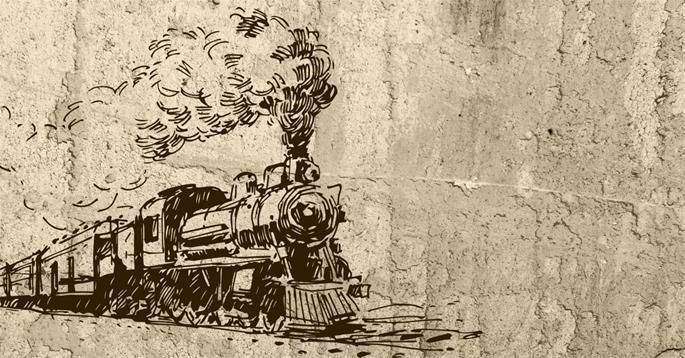
First-Class Stowaway
by Naftali Silberberg
Around the turn of the twentieth century, Vladimir, an illiterate and unworldly Siberian peasant, struck it rich. One day he was offered a very lucrative business proposition. Closing the deal, however, required his presence in Moscow.
Moscow. He was pretty sure that a horse - even the sturdiest his village had to offer - would not be able to make the trip of several thousand kilometers . . . Some of the more sophisticated residents of the town came to his rescue, advising him about the existence of a new mode of transportation, a “train.” If he were to travel to Novosibirsk, the closest large city, he would be able to catch a train to Moscow.
Thus, one fine day found Vladimir in the central train station of Novosibirsk. When he informed the lady behind the ticket counter of his intended destination, she asked him what sort of ticket he wished to purchase. Observing his confusion, she told him that he could purchase a first-, second- or third-class ticket. A third-class ticket, she explained, offered absolutely no amenities, and didn’t even guarantee a spot on the train. If the arriving train was already filled to capacity, he would have to wait for the next one. A second-class ticket offered a greater chance of a spot on the train, along with more comfortable accommodations. A first-class ticket came with a guaranteed seat, and all amenities necessary to ensure a luxurious and comfortable journey.
Money was hardly an issue, so first class it would be. The ticket lady explained to her consumer that the ticket was non-refundable, and should be guarded carefully. Vladimir heeded her advice, and tucked his ticket beneath the many layers of clothing he was wearing.
As it turned out, the train would not arrive for another few days. Vladimir noted the date and time of its anticipated arrival, arranged for lodgings in the interim, and arrived back at the station two hours early, since this was his first time attempting such a journey. He decided to just follow the flow, assuming that he would be fine as long as he copied exactly what his fellow travelers were doing.
The train arrived. After his initial shock at seeing such a monstrously large caravan of cars, Vladimir regained his composure and scanned the terminal to see what to do. As it was early, most of the passengers had not yet arrived, but he noticed three passengers boarding the very last car on the train. He followed them into the car, and when each one climbed beneath one of the benches in the car, he did the same. Unfortunately, he wasn’t fully familiar with proper stowaway protocol, and his feet jutted out across the aisle of the third-class car.
It was dark and lonely beneath the bench, and Vladimir quickly dozed off. He didn’t feel the train start to move, and didn’t hear the conductor entering the car. He did, however, feel a sharp kick to his shins, and the startled peasant was expertly hoisted out by the burly conductor.
“You moron, you think this is a free ride?” he bellowed. “You need a ticket to ride this train!”
“What’s the problem, sir,” Vladimir meekly responded. “I have a ticket.”
The other travelers on the train car burst out laughing at this ludicrous claim. Their laughter only intensified when he started peeling off layer after layer of clothing, starting with his expensive fur coat and ending with his undergarments. But, much to their astonishment, he pulled out a ticket - a first-class ticket, no less!
After verifying that the ticket was indeed authentic, the conductor, in a distinctly humbled tone of voice, asked the obvious: “Sir, you have an expensive first-class ticket; pray tell me why you are lying under a bench in the thirdclass car?!”
“Because that’s what the others were doing . . .” was the embarrassed response.
We, too, travel through life’s long journey. At Mount Sinai, we were given a first-class ticket. One day, the Conductor will want to know whether we used it or not.

Brian Hirschfield, DDS
Thirty years of experience. Helping people achieve their lifetime dental goals….one patient at a time. www.livoniasmiles.com 585-346-3028

WHAT IS THE TORAH?
The word Torah means “instruction” or “guide,” and it is often described as G-d’s “user manual” for the world. But unlike an ordinary user manual—which is secondary to the product it explains—the Torah is primary, not secondary.
The Torah isn’t a guide for managing an existing creation—it’s the reason creation exists. The Talmud states that the world was created in response to the Torah. G-d created the world so that the instructions of the Torah could be lived and fulfilled.
The same is true for each of us. Rather than seeing yourself as a victim of random events, recognize that your divine mission is the primary focus, and your current life circumstances only play a supporting role, not the other way around.
For example, in 1967, when a snowstorm left a group of Jewish women stranded and stuck in a Detroit airport, they called the Rebbe for guidance, and he famously responded, “A Jew is never stuck; wherever you find yourself, it’s by Divine design.”
The story beautifully illustrates how even snowstorms and flight cancellations are secondary and divinely orchestrated to help facilitate the Torah’s primary mission. Inspired by this message, the group of Jewish women used the unexpected delay in Detroit to connect with other stranded Jewish travelers, resulting in new relationships and a lasting Jewish impact.
Similar to how you’ll see online ads in your feed based on your demographic, location and preferences, the Baal Shem Tov taught that everything we encounter in our lives is by divine design. For instance, if you notice a flaw in a friend, it’s only showing up in your “feed” to serve as a mirror, highlighting something within yourself that requires attention.
Can there be anything random in a world created and designed only to facilitate the Torah?
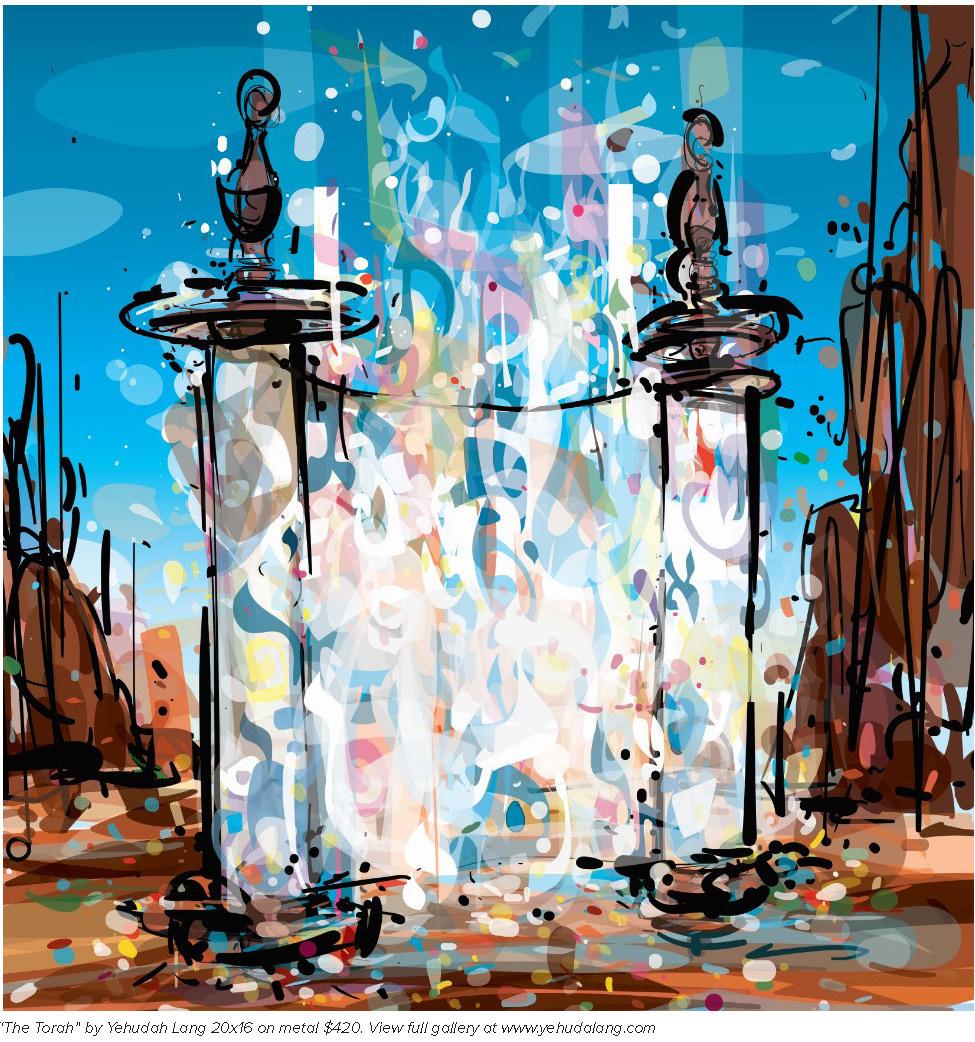
WHAT IS THE TORAH’S PURPOSE?
In short, the Torah’s objective is divine unity.
This unity isn’t about being alone, the only, or having no opposition. Absolute divine unity is revealed when the Torah transforms and includes even the most distant or seemingly opposite elements within the realm of holiness. As the light that was once darkness shines much brighter, and the peace that can bond enemies is much stronger, this Torah-enabled unity is a more profound oneness.
But to unite and uplift the world, you need to be above it.
That’s why the Torah is in a constant state of being “given,” as G-d makes sure the Torah retains its primary transcendent nature. This is similar to aerodynamics, where you need an outside force to lift yourself, and for creation and all its messy parts, the Torah is that “outside” force.
So, look deeply into the Torah and watch how the distance between heaven and earth dissolves and see how “commandments” connect and elevate you, and the world’s countless details with endless scenarios, into a profound divine oneness. •
(Based on a Chassidic Discourse by the Rebbe)
The Torah is the oxygen for a world gasping for truth. - Psalms 19:8
The Torah is the nourishing water for parched souls. – Isaiah 55:1
The Torah is the light that guides a world shrouded in darkness. – Proverbs 6:23
The Torah is the living living tree with branches that touch every aspect of life. – Proverbs 3:18
The Torah is the bridge that allows finite, earthbound humans to touch the infinite. – Hayom Yom 8 Adar I
The Torah is the map, guide, and tool to fulfill the very purpose of creation.
IT’S PERSONAL.
Shavuot isn’t only about what was given; it’s about who it was given to. And the answer is: You. The Torah doesn’t belong to scholars or sages alone. It’s not a reward for good behavior or a gift for the spiritually elite.
It’s an inheritance, which means it’s yours by birthright. As the verse says, “The Torah that Moses commanded us is the inheritance of the congregation of Jacob.”
The Rebbe explains this beautifully. A paycheck is earned. A gift is given. But an inheritance is different, it’s yours by virtue of who you are, not what you’ve done. No one earns their inheritance. You don’t have to qualify for it. It is part of you.
This holiday, take it personally. When you stand in Synagogue and hear the Ten Commandments, don’t think of it as a grand event from the past. Think of it as your inheritance being handed to you again. The Torah is yours. It belongs to every Jew. So go claim it.
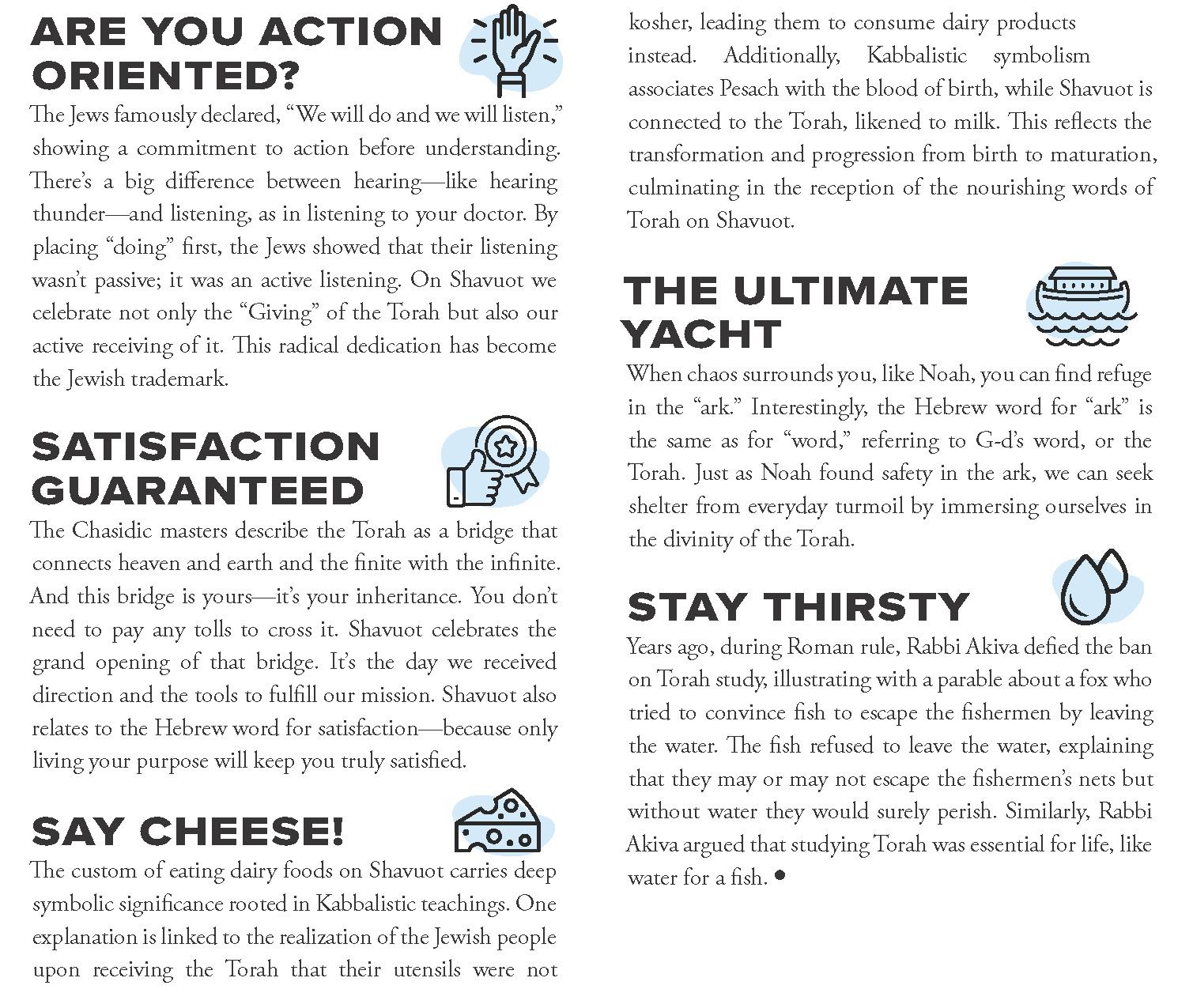
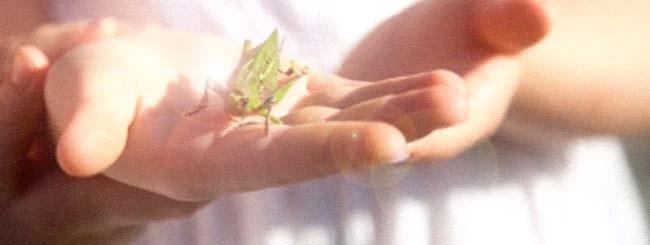
How Do We Know the Torah Is Real?
by Shimona Tzukernik
Some months back, as I put my twins to sleep, Aronchik popped the question.
“Mommy . . .” he said hesitantly.
“Yes?”
“. . . Are you my mother?”
My heart smiled, remembering thinking and asking the same question of my mother. “Most definitely!” I said.
“But . . . how do I know that you’re my mother? How do you know? Maybe the nurse switched me and brought you the wrong baby . . . ?”
He nestled closer. And, lying arm in arm, we continued to philosophize, until he fell asleep.
Our discussion reminded me of some moments after recess, back in the fifth grade. I was returning to class from the playground, kids in front and back of me and the bell blasting. Blue poles lined the path. I felt their pull, much like the force of the tide within a wave. It seemed to me I was standing still and the poles pushing past.
ten-year-old girl, I could believe the world was real. But was it possible to know it? What had to be added to that belief in order to convert it into knowledge?
This concept is centrally relevant to the festival of Shavuot, which celebrates Giving of the Torah. The Giving of the Torah is the event upon which our entire practice hinges. Lighting Shabbat candles, putting on tefillin, the laws of inheritance, the prohibition against taking interest on a loan - all the myriad rules governing life for a Jew are based on the fact that on a Shabbat morning, the 6th of Sivan in the spring of the year 2448, G-d communicated the purpose of Creation, and His will, to the Jewish people.
Before plunging in to the deeper meaning of all those details, it’s appropriate to ask ourselves, “Is it true?” It’s like checking in, “Are you my mother?” For all we know, the Ten Commandments might be a list of ethical values compiled by a group of people who developed a personal philosophical and legal system by which to live - or by a select few seeking to control the masses. The possibilities are numerous, and logically seem to outweigh the notion that the Creator clearly communicated His infinite Being to us little people.
“Belief” traditionally implies that we accept a concept as being true despite the fact that it is beyond our understanding. As a ten-year-old girl, I could believe the world was real. But was it possible to know it? What had to
be added to that belief in order to convert it into knowledge?
All religions and spiritual paths lay claim to being True. Christianity claims one thing, Islam another, Buddhism yet another. The list is as long as the religions to which people around the world subscribe. They may overlap on certain issues, but the bottom line is that they all contradict every other religion, or brand thereof, in some way. There is no way that both Christianity and Islam can be absolutely true - because they contradict each other. The same thing applies to Judaism: it is at odds with every other religion in some way or another.
“Am I real?” I thought. “Are the poles? And the people?”
I pondered this all the way back to class, questioning not only where I came from, but whether I had any way of being able to verify my own existence.
“Take out your biology books.” And within minutes my mind became absorbed in the green grasshopper, following the splices in my textbook - head, thorax, abdomen, legs - absorbing the details of the big picture whose veracity I had questioned just moments before.
Although I didn’t yet know the word epistemology, that’s what my head was trying to wrap itself around: the study of knowledge and how we justify our beliefs. “Belief” traditionally implies that we accept a concept as being true despite the fact that it is beyond our understanding. As a
So, how do we know that it is the will of G-d as transmitted to Moses and the Jewish people at Mount Sinai? And in what way is Judaism’s claim to Truth different?
There are intellectual and religious traditions that flounder upon the marsh of their own reasoning. In my youthful mind, I relegated Judaism to those same backwaters. But in my bones, my innate belief was rich as marrow. It pushed me to search for rational explanations that would be compelling enough to draw my faith into the realm of knowledge.
Along the way, I attended a midwinter camp while still in my teens. On Shabbat our counselor sat with us on the dry grass, beneath a sun that glared so potently I could hardly keep my eyes open. The text in my lap was the Kuzari. Written by Rabbi Judah HaLevi, it chronicles an
imagined conversation between a rabbi and the king of the Khazars, as the latter searches for the truest way to serve his Creator. It changed my life. I sat down that morning replete with questions, and even skepticism. I stood up on a new foundation.
At one point, the rabbi asserts that “one cannot arrive deductively at the Truth.” That may sound simple, but it was a revelation to me. I was deeply rooted in the notion that I’d begin with myself, search, develop understanding, and then arrive, through that process of deduction, at the Truth. What was being communicated to me was that we can arrive at the Truth only inductively. In the words of the Kuzari, “The conditions which render a person fit to receive divine influence do not lie within him . . . Whosoever strives by speculation and deduction to prepare the conditions so as to receive this inspiration . . . is an unbeliever.”1
In the morning liturgy, we read the famous song Ein Keilokeinu, which, line after line, praises the Creator. “There is none like our G-d,” it says. “None like our King, our Master and Redeemer.”
The second stanza asks, “Who is like our G-d?”
The first time I had read it, I was struck by the apparent flaw in logic. Surely one would first ask, “Who,” and only then, after all the inquiry, arrive at the conclusion that “there is none like our G-d”? I understood from the Kuzari that if we approach G-d in that way, we are, in essence, creating Him in our image. By deduction, I can arrive only at an entity as great as my own mind. But, counterintuitively, when I surrender my notion of what-is - how things are supposed to be and what “G-d” is - then I am able, through diving into the wisdom of the Torah, to access the infinite which lies beyond me.
cannot arrive at G-d following a step-by-step path that begins with the self, so too with regard to humanity at large. If G-d did indeed communicate His will to the Jewish people, then He did so in one instant. The divine revelation upon which our belief is based must have occurred at one moment in time. Either G-d was communicating to us, or He was not.
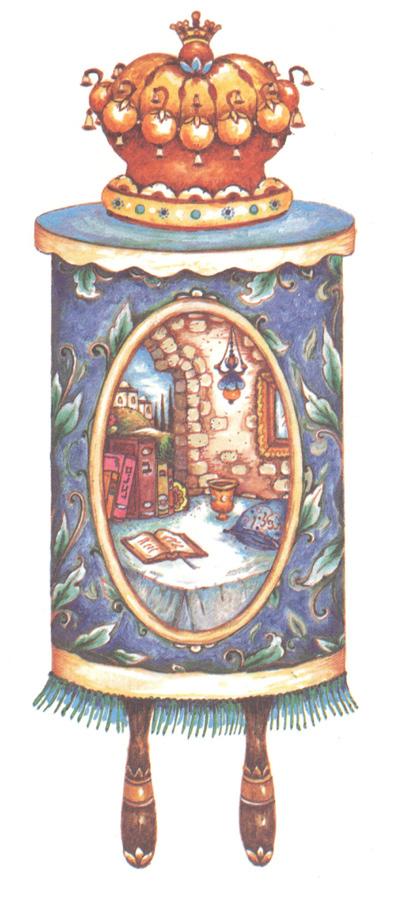
And, if the setting meets certain criteria, then from that moment onward, the revelation holds a validity that carries it forward. In their discussion, the rabbi emphasizes to the king that there were over two million Jews who lived in Egypt and endured slavery, heard the promise of redemption, witnessed the ten plagues, experienced the Exodus and the crossing of the Sea of Reeds and then on into the desert. He adds that not one of them had separated or lived elsewhere at the time these events occurred. Furthermore, all these people experienced these things together over a period of forty years.
The king of Khazaria readily accepts the rabbi’s claims to divine revelation and Truth. He accepts that religion does not evolve, but that rather there is a spontaneous eruption, a revolutionary moment that arises out of this revelation. And he accepts what the people themselves came to through witnessing the revelation, namely that Moses held direct communication with G-d.
What is it about what the rabbi said that persuaded the
This does not imply “blind” faith, though. There is a rational component to Jewish belief. Our tradition marries the supra-conscious and the rational in the most remarkable way. We’ll come to that. For the moment, though, let’s hold on to this notion that if we are the point of departure, we cannot arrive at G-d.
Rabbi Judah HaLevi takes this notion a step further. He states that even if a religion grows in a grassroots fashion and takes hold of a collective consciousness, it has no more validity than the subjective fancies of an individual. Religions of divine origin don’t “grow” and “spread,” because they don’t begin with the people. With religions of divine origin, there is no need to unite differing opinions or lay the foundation of the faith, working and reworking it until it takes on a complete structure. As the rabbi answers the king, “Only rational religions of human origin can arise in this way . . . a religion of divine origin arises suddenly. It is bidden to arise, and it is there, like the creation of the world.”2
What this means is that just as with the individual one
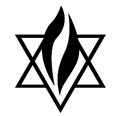
The Chabad Times - Rochester NY - Sivan 5785 king so readily? Here’s where logic comes in to play. Let’s assume that this notion of the Giving of the Torah is just a claim. Can we authenticate it? Yes. Because the nature of the claim lays itself open to being proven true or false.. The philosopher of science Karl Popper asserts that a theory must expose itself to being disproved - otherwise it’s pseudoscience. And the same applies to history. If an event can’t stand up to being proven true or false, it cannot be classified as a historical fact.
Let’s contrast, for example, the attack on the World Trade Center and the story of the flight of Icarus to the sun. Why do we term the former a historical fact and the latter a myth? Because the former exposes itself to being disproved, whilst the Greek tale doesn’t. A claim is made that two airplanes flew into the towers on September 11, 2001. Imagine that I’d never heard of such an event, and challenged you to prove it. You could. You’re making a claim that you can prove, and that I could disprove. I could search for evidence and find none, and thereby refute what you’re telling me. You could show me footage of what happened, written testimonies, eyewitnesses - and prove that it happened. But with the story of Icarus, we can’t do that. The claim is that there were no witnesses to corroborate the event. Either I believe you or I don’t. I can’t logically challenge it.
had joined them. The account of the Giving of the Torah clearly states that every individual was there. And then it repeats that claim over and over. When Moses communicates his parting message to the people forty years later, he reiterates the claim again and again. Why the necessity to emphasize it? Because such a claim most certainly stands up to the test of being proven false.
Could you imagine someone making such a claim today?
“Yesterday, at midday, the entire Jewish nation stood on the shores of Jamaica and, amidst lightning, thunder and booming waves, heard G-d communicate a new version of the Bible.”
It’s
Let’s look at it from this angle: Imagine that the assertion was that “many” or “most” people were there. Now, one generation down, along comes a kid and asks of Mom and Dad, “Were you there?” and they answer, “No.” That child with that question would not necessarily thereby have disproved the event, but she’d certainly have room to doubt it. But if the claim is that every member of the people was present, and the child says, “Folks, did you witness it?” and they say, “No, not us” - well, then, the claim’s been invalidated in that instant! “The claim is that it was experienced by everyone without exception, and here you are telling me that you weren’t there!?”
preposterous! We’d laugh at the person, or cry for him and call for psychiatric intervention.
Where do religious claims fall in to the mix? History or myth? Fact or fiction? Remarkably, all religions base themselves on a revelation or event that happens in private - such as arising from the dead before a handful of people, or ascending to the heavens alone. In fact most religions don’t lay claim to any more than one individual or a small group as being privy to divine revelation. Why? Because that way, no one can refute it! There is simply no way to verify - or falsify! - the claim. Either you believe them or you don’t. “He said.” You believe him and I don’t. In essence, the foundation of all religions is, from a philosophical perspective, not a provable historical fact.
Judaism is the only exception. The Bible states that G-d revealed Himself to the entire nation at the same time! No other nation ever made such a claim, because it would be immediately exposed.
Think about it for a moment. The Bible repeatedly states that every member of our tribe stood at the base of Mount Sinai and experienced G-d’s communication. According to the claim, there were 600,000 males. Plus their wives and children (and supposedly, there were many of them, because all the women, we are told, had multiple births each pregnancy). Then there were the Egyptian converts who
So, just one generation later, this audacious assertion would have fallen apart. If even one child born after the claimed occurrence had been told, “I didn’t witness what happened,” then the whole story would be up in smoke. And so on to the next generation. All the way to us. If we generously assume there are five generations per century, we’re looking at roughly one hundred and seventy links in the chain. And, in some way, our acceptance of the veracity of the event requires no more than what was necessary for the children of those who personally witnessed it. It has been an unbroken chain.
Certainly, there were Jews who challenged the oral tradition. But even the Sadducees didn’t deny the Giving of the Torah! How could they? We have no tradition of anyone who said, “Sshhh. Let’s keep this to ourselves, but . . . it’s all bogus. So-and-so made it up.” Could you imagine someone making such a claim today? “Yesterday, at midday, the entire Jewish nation stood on the shores of Jamaica and, amidst lightning, thunder and booming waves, heard G-d communicate a new version of the Bible.” It’s preposterous! We’d laugh at the person, or cry for him and call for psychiatric intervention. Or, let’s say someone said, “Yesterday, the Twin Towers rose from Ground Zero.” Come on! It’s an impossible con. You can’t make something like that up, because no one would accept it - it lays itself too open to falsification. No one in our history, from the Jewish people’s stride up the Fertile Crescent and into the Holy Land and down through the ages, could have made up the
story of Sinai. It would instantaneously have been crushed with disdain and laughter. So, while the oral tradition may have been challenged, no one ever denied the Giving of the Torah.
I hear you thinking, “My folks denied. And their folks too!” But . . . with all due respect to your folks, those statements defy logic. Where are they drawing that tradition from? Where are the people going all the way back - 3327 years - who corroborate that? Prove to me that it didn’t happen. Where are your sources? The painful facts are that a history of pain and persecution has blinded us to our heritage, has covered our faith with soot and darkened our minds. Our ancestors were observant Jews. That’s how we know we’re Jewish today. And, for those who lost their faith to the sufferings of exile even earlier, their offspring most likely don’t even carry the knowledge of their own Jewish identity. It’s the same scenario as what happened to the descendants of the lost tribes, or the Sadducees.
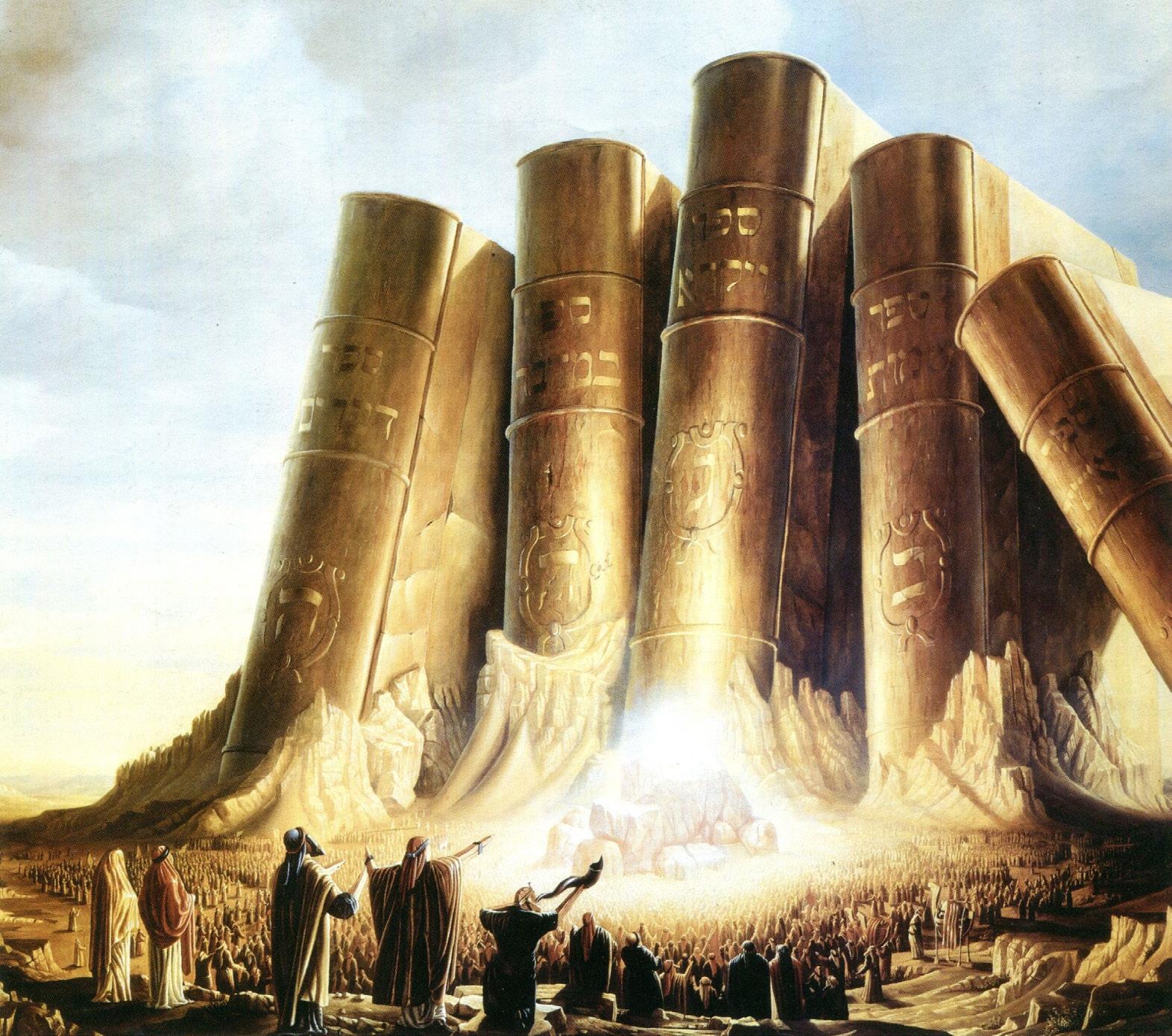
From a purely logical point of view, the claim of mass revelation compels us to an acceptance of the biblical account of the Giving of the Torah. So why the resistance to its acceptance as a fait accompli? Many of us are still likely to be more ready to recognize that Napoleon battled at Waterloo, or that Van Gogh cut off his ear (though apparently, current theory denies that - seems it was Gauguin who done it!) than to accept that G-d brought a plague of frogs on Egypt and spoke to the people from a cloud. Why? According to the principles of logic, it makes so much more sense that those things did happen than that they didn’t.
I’d venture to say that our minds are bribed by our bodies. To accept that Napoleon lived makes no demands on my life. Van Gogh cut off his ear; I might find it psychologically compelling, but it doesn’t ask of me to do anything different. But if our ancestors really heard G-d communicate the Torah, well, that’s another story entirely! If I bought in to that . . . then I’d have to forego the cheeseburger, or the mini-dress. I’d not be able to tour the world in the way I do now. I’d have to give up Saturday’s income. But that’s embarrassing, isn’t it? To casually say no to the absolute Truth and purpose of my existence because my stomach is rumbling and my financial appetite is big? Just doesn’t fit with our image of ourselves as so-
phisticated, people of integrity. So we dress our desire up in roundabout logic, and say, “Preposterous. It makes no sense. Seas don’t split, and G-d’s voice is not heard by bubbies and babies on Shabbat mornings anywhere, anytime! Now... what’s for dinner?”
If we want to understand the world - the grasshoppers and where we come from - if we want to live in accordance with Truth, we must be willing to follow the answers to their end point. They may be uncomfortable. But then, where in that big book did G-d say it would be easy?
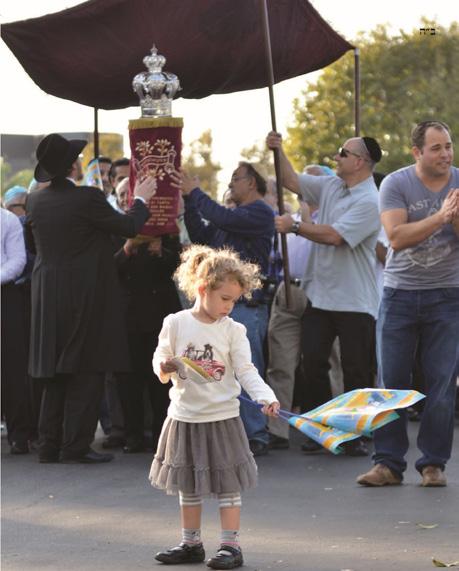
You can help ensure that the flag of Jewish Identity will continue to fly. Remember Chabad of Rochester in your will. www.chabadrochester.com/legacy

Why Do I Pray?
by E.G. “Jerry” Farris
Having been raised in a somewhat agnostic family, prayer was a bit alien to me for quite a long while. My family believed in G-d, but were a bit reluctant to profess any true and solid faith. My father, of blessed memory, had been in one of the first American battalions to enter Auschwitz during WWII. What he saw there seemed to haunt him for the rest of his years. As a result, he refused to follow anything that meant religious commitment. I can still hear him saying, “Some day, perhaps, some day; just not now.” But “some day” never came.
As I grew older, I tried various religious avenues on my own. Yet nothing felt completely right. I always felt a bit out of place even though I couldn’t put my finger on it. One of the things that always bothered me, every place I tried, was that not once did anyone even ask if I knew how to pray, ask me to pray, or inquire as to my ability to pray. It seemed as if I was simply expected to know how to do this and why. It makes one stop and wonder: if it is such an important thing to do – pray, that is – then why wasn’t it taught, or at least talked about
These Things I Bring
by E.G. “Jerry” Farris
I bring to You, These feet of mineBroken, hurtful, Yet willing to walk to You.
I bring to You, My weakened legsThough muscles wane, They are ready to carry me to Your door.
seemingly anywhere? It was something I would have to find out about all by myself.
As years went by and I aimlessly visited places of worship here and there, I began to listen to what others prayed about, and how they went about it. It was a very interesting thing, this praying. Some, like me, had a very difficult time trying to find the “right” words to say; to use words that would be satisfying to everyone around them.
Then, there were those who had a gift of sorts; who could pray at the literal drop of a hat with prayers that lilted like a song from their lips. Some could make you feel guilty because you could not pray like they did; others made you glad you didn’t. Some would repeat G-d’s name over and over as if the repetition was the “key” to getting the prayer answered.
As time passed, I came to the realization that prayer is as individual as the sands in an hour glass. Singularly, they didn’t seem like much and their importance might feel like little; but together, ah, together, they were as mighty as the beaches. They become firm and yet are a cushion against a mighty sea of adversity.
When I first saw all the prayers in the Siddur, the prayerbook, I thought it strange. “What good are these prayers if they are said by everyone the same?”
When I took the time to stop and think about it, it became very clear.
It wasn’t until I discovered Judaism that I found a real reason and need for prayer. When I first saw all the prayers in the Siddur, the prayerbook, I thought it strange. “What good are these prayers if they are said by everyone the same?” I thought. When I took the time to stop and think about it, it became very clear. As individuals, our prayers may seem insignificant; though in truth they are quite powerful, but even more so, when joined by the prayers of millions of other Jews they become powerful – bombarding Heaven’s gates with the pleading of a people who not only find reason to praise, but to ask together as a whole, for both healing and forgiveness. Continued on bottom of next page
I bring to You, A body, failing daily; Inside beats a heart, Filled with love for You.
I bring to You, A voice for singing; For Your praises are Most worthy to be heard.
I bring to You, A mind to fill –
That in its knowledge, Wisdom may rule.
All these things I give to You, For You first gave them to me. I offer them in humility; Asking that You use them in a way That serves Your purpose.
Of all these things I offer one more My spirit; That by serving others, I may serve You also.
My selfish sacrifice then, Is me…. To You.
Dignity
by Jay Litvin
Okay, so I yelled a little too loudly when I yelled at my daughter. Okay, so maybe she didn’t deserve as much of my anger as I let out. But, she did deserve some of it, didn’t she? I mean, after what she did, could I just let it pass? Not say anything? Pretend it didn’t happen?
Who would she become, then? Should I just tolerate everything for the sake of not getting angry?
Okay, so it does make the house unpleasant and casts a pall over the evening, after I yell and she walks off with that look on her face and goes to her room and closes her door.
You’re right, it scares the other kids, who just sort of look away and stay quiet for the rest of the evening, hoping I won’t get mad at them.
And yes, I was in a bad mood when I came home, and yes, that did have some bearing on the way I responded. But still, should I have just let it pass? I mean, doesn’t Chaya need some discipline, sometime?
“Your dignity,” my wife said.
“What? What does my dignity have to do with this?”
“When you yell like that, you lose your dignity.”
WHY DO I PRAY?
Continued from previous page
The power of the masses is never more than in come together as a whole before our Creator!
Why do I pray? Sure, prayer brings me closer to G-d; but prayer also brings me closer to my fellow Jews, closer to the needs of my fellow mankind, closer even, to my own understanding of myself. I have discovered that prayer is the key to self-understanding, self-forgiveness, and even self-acceptance and love. If we cannot understand, forgive and love ourselves, it becomes impossible to hope to understand – even a little – or to accept or love G-d.
So, in one sense, prayer becomes a bit selfish or selfcentered in my search for peace and tranquility in this life. Yet it is far from that in its totality. For in prayer I am connecting with the universe; going beyond the limits of time and space as we know it – connecting with the Supreme, the ultimate Source of life! Together we can change the world as we know it through our spiritual connections in prayer.
That change is a spiritually fulfilling change that in turn changes the way we look at the world around us; how we perceive it and what we contribute to it. It is a selfchanging yet universally connecting change far from the understanding of many. This somewhat mysterious mani-
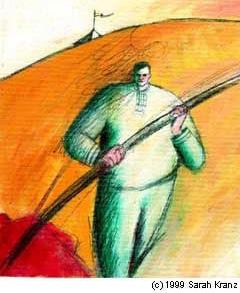
“My dignity?” I questioned with exasperation. “I thought we were talking about her, about her behavior, her need to be taught right from wrong.”
“You can do that with dignity,” she said again. “When you lose your temper, you lose your dignity.”
Okay, she got me. I sat down, ready to hear more. I took Continued on next page a
festation of prayer-induced change may seem beyond the realm of reality, but it is my reality for now; and just a small part of the unexplainable reasons I pray.
I like knowing I am connecting with others – even people I have never met – to petition my Creator for the needs of many; putting my own needs last. This letting go of me, this, was probably the most difficult of things I learned; but the most necessary. Once I was able to get beyond “me” when I prayed, I was able to open my mind and spirit to the needs of others. Then is when I found that relationship with G-d that is special, warm and accepting. Like a child sitting at the feet of her father in quiet repose, sometimes saying nothing at all, yet speaking volumes; and in turn basking in the warmth of his presence. It is like that and more. It is a closeness that is as individual as that grain of sand, yet as firm as the solidity of the beach; a connection that in its totality repels the onslaught of adversity in my life. And that is one of the best reasons, I find, to pray.
E.G. “Jerry” Farris served in the US Air Force and the Jewish War Veterans of the USA. She is a writer of a humor column for the Disabled Dealer Magazine in which she discusses the struggles of living with a physical disability. Most importantly, Jerry is the proud mother of twin girls and three grandchildren.
The Chabad Times - Rochester NY - Sivan 5785 a deep breath and tried to stuff my defenses in my pocket long enough to hear what she had to say.
“Chaya loves you,” she explained convincingly. “She craves your approval. Your slightest look of displeasure is picked up by her and all the children.
“If you had simply grimaced,” she continued, “it would have given her the message, taught her the lesson, and, yet left your dignity intact.”
“Just grimaced?” I asked, disbelievingly.
“Just grimaced,” she repeated. “Chaya - all of them - are totally tuned in to you. You are their father. They love you and want you to be happy with them. When you’re not, they notice and it matters. If you believed this, you wouldn’t have to get angry. And if you didn’t get angry, you’d keep your dignity. And if you kept your dignity, you’d teach them how to keep theirs as well.”
“Painful,” she said. “Straight into their little hearts. The hearts that love you.”
Oh, my!!
“But I don’t want to be so responsible with my behavior,” I screeched. “What about spontaneity,” I pleaded. Can I ever be myself again? I cried out to the One Above.
Dignity. What a word. What a concept. What exactly did it mean? How could you lose it? Where can you find it?
“You’re on your own. Figure it out. You’ll get it,” she said with confidence, and in such a way as to preserve my... yes... dignity. We ended the conversation with my ego intact.
So, I started my research where any good student would go: To the dictionary.
Whoa! This was a lot to take in. Too much to take in. And how did my wife get so wise? And where did she even find the courage to say all this to me, this husband not especially known for accepting criticism in the lightest of ways, especially from his wife; this person who often saw criticism when there wasn’t even any around.
Was there any around?
Well, I looked and I couldn’t find any. It felt close to criticism. It had some of the texture and smell of criticism. But there was something in the way she was telling me all this that didn’t feel like criticism. But it did feel really important. Like something I should hear if I could just get my ego out of my ears.
“You mean to tell me that if I just grimace, the kids will get the message?”
“Yes,” she said, “though you might also have to explain what you’re grimacing about. But you don’t have to yell to do that. Your displeasure is loud enough.”
“And when I yell?” I asked.

“Of course,” she replied. (My wife, not the One Above.) “Just don’t get so angry. You don’t need to, and it hurts your dignity. And the kids want you to have dignity.”
Dignity. What a word. What a concept. What exactly did it mean? How could you lose it? Where can you find it?
“You’re on your own. Figure it out. You’ll get it,” she said with confidence, and in such a way as to preserve my . . . yes . . . dignity. We ended the conversation with my ego intact.
So, I started my research where any good student would go: to the dictionary.
Dignity: The presence of poise and self-respect in one’s deportment to a degree that inspires respect; loftiness and grace. Syn. Decorum.
Intrigued, I followed the link to decorum.
Decorum: . . . suitableness of speech and behavior to one’s own character, or to the place and occasion . . . Poise in behavior.
Poise again. I had to check that out.
Poise: To be balanced; the state or condition of being balanced.
This is what my wife was talking about, wasn’t it? “. . . suitableness of speech and behavior to the place or occasion . . . ,” “poise and balance.” My anger had been out of balance with both the occasion and my daughter. I had done the opposite of “inspiring respect.”
I began to think of my little Chaya trying to receive and contain my outburst of negative energy. I was angry for

my own sake, not for hers. I had not only lost myself, but I had forgotten my daughter as well. She was simply overwhelmed by my intensity, unable to absorb or understand it. She was frightened, and I could envision her little mind and heart bursting from the power of my voice and words and facial expression. There was no way this anger could have any positive effect. My anger was only delighting in its own expression. And in behaving like this, I had lost, as my wife said, my dignity. And my daughter had suffered the consequences.
Later that day, I was studying a book on the sefirot, the ten divine “attributes” which G-d assumes in order to create and interact with our existence.
I was learning about chessed (kindness/outpouring), gevurah (restriction/containment), and their merger in tiferet (beauty, or what I might now call dignity).
In the description I was reading, the word “balance” was used to describe tiferet, as the dictionary had used this word to describe dignity, decorum and poise.
The passage was describing the balance between “outpouring” and the receptacle to contain it. When the ideal balance exits, beauty is the result. When things fit together properly, when form perfectly matches content, when balance occurs and proportions are correct, things are beautiful. They have grace and poise.
And when applied to behavior, I thought, they have dignity and decorum.
The Kabbalists say that when the outpouring is greater than the vessel can contain, the result is a “shattering of the vessel.” When the outpouring is too little, the result is a vessel left in need. But when the outpouring is, as Goldilocks says, just right, the vessel just big enough - the result is beautiful, a perfect fit.
Again, it was not difficult to see the relevance to my daughter and my behavior. And as I continued to read, it was as if the words were printed over a vague outline of her face looking up at me, sometimes smiling, sometimes expressing the shock and anguish she felt as I yelled at her.
The passage continued to describe the way that G-d constricts and restricts Himself so that each container, no matter how small, is provided just the right amount of G-dliness without breaking. And I now had a glimpse of what was required of me. As challenging as it seemed, I figured that since I was created in the image of G-d, He had probably given me the resources I needed to accomplish what seemed the impossible.
I would need to match the outpouring of my expression to fit my daughter’s ability to receive. And this would require that I come to know her
ability to receive, that I tune deeper into her sensitivities, the size of her heart, the fragility and strength of her emotions, her capacity to understand her own behavior and mine, and to keep this knowing foremost in my mind and heart.
Returning again to Chassidism and the order of the sefirot, I related this level of knowing to the sefirah of daat, which precedes and influences the sefirot of chessed (outpouring, expression) and gevurah (restriction, containment).
Though daat is preceded by, and is a combination of, the sefirot of chochmah (wisdom) and binah (understanding), it is not an intellectual knowing, not a mind knowing, but a deeper knowing - an intimacy with the other that bridges the distance between subject and object, between knower and known.
As I thought about my daughter, I related daat to the kind of knowing that occurs between parents and children at their best. The sort of knowing available to those created of the same blood, seed and egg, the same DNA and soul, the same family and home. It was difficult for me to contemplate this level of knowing without imagining the

The Chabad Times - Rochester NY - Sivan 5785 deep love that would result, and the overwhelming desire to give and be kind to that which comes to be known in this intrinsic way.
Thinking about this and my little Chaya, my love and affection for her filled my awareness, and as I remembered yelling at her on this unfortunate morning, my behavior now seemed unbearably abhorrent and cruel.
Seeing now how ugly I had acted and the pain I caused her, I marveled at how kind my wife had been to me. At the time, I could not have listened to a description of my ugliness without shutting out my wife’s words in my own defense. In her wisdom, she had chosen words that I could hear and learn from. She had spoken to me not of ugliness, but of dignity.
I now had this strange feeling that Chassidic teaching was telling me how to be a better father and husband, and my daughter and wife were teaching me how to better understand Chassidism, and myself.
I began to see that I would not, as I feared, be de- nied my spontaneity. Though my behavior would no longer be controlled by outbursts of emotion, neither would it be the artificial result of stiff, premeditated thought. From coming to know my daughter - or my wife - in the ways that Chassidism described, I saw the possibility that my expres-
sion could rise from a different kind of spontaneity, one that sprung naturally from my best mind, from my open heart, from my caring and love.
I saw the possibility of maintaining my dignity while giving my daughter the ability to receive and learn from that which I wished to impart, as my wife had given that opportunity to me.
And I saw that the result would be beautiful, in the way that all things are beautiful when they fall from the mind into the heart to be expressed by our actions and words.
To my daughter, my apologies. To my wife, my gratitude. To Chassidism, my appreciation for the refinement you bring to my life.
Jay Litvin was born in Chicago in 1944. He moved to Israel in 1993 to serve as medical liaison for Chabad’s Children of Chernobyl program, and took a leading role in airlifting children from the areas contaminated by the Chernobyl nuclear disaster; he also founded and directed Chabad’s Terror Victims program in Israel. Jay passed away in April of 2004 after a valiant four-year battle with non-Hodgkin’s lymphoma. He was a frequent contributor to the Jewish website Chabad.org. His essays can be found in the book, The Life I Have: Essays on Fatherhood, Finding Judaism and Illness.

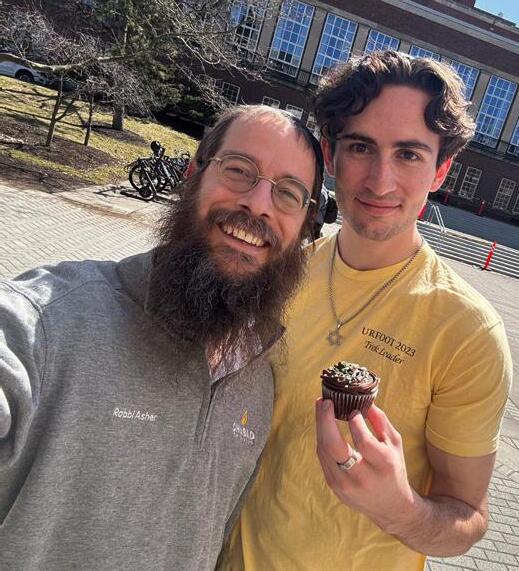
Reaching Out at U of
R, R.I.T. , SUNY Geneseo, Sunshine Circle and Young Jewish Professionals
